09/2024
SEPTEMBER-OCTOBER 2024

Contractor appointed to build £15m community health centre
Keyworker housing model supports recruitment and retention of staff
Investors and property developers remain interested in health and care sector



09/2024
SEPTEMBER-OCTOBER 2024

Contractor appointed to build £15m community health centre
Keyworker housing model supports recruitment and retention of staff
Investors and property developers remain interested in health and care sector


Since the last edition of Healthcare Property magazine, there has been a change of government, with the Labour Party taking power.
In the run-up to the ballot, the party put forward a number of proposals to improve health and care services, including cutting waiting times, doubling the number of cancer scanners, reviving NHS dentistry services, reforming employment support, and re-opening the door to primary care.
And some further detail was provided in the King’s Speech on 17 July, where health-specific announcements included reforming the Mental Health Act and tackling smoking by raising the age of sale of tobacco products.

But the Government was largely silent on the issue of capital spending on the healthcare estate, with new Health Secretary, Wes Streeting, also announcing an urgent review of the New Hospital Programme (p6), admitting that ‘it’s painfully clear that the previous government’s New Hospital Programme, that said they would deliver 40 new hospitals by 2030, is not deliverable in that timeframe’.
This will mean hospitals continuing to struggle with outdated infrastructure that they do not have the capital to address, alongside other pressing issues such as RAAC and asbestos.
In this edition of Healthcare Property you can
About Jo: Jo is the editor of Healthcare Property, having joined Nexus Media in November.
She has been specialising in design and construction best practice within the health and care sector for the past 15 years, working on the Building Better Healthcare
read more about the impact of the change of government on the sector; including details of Handelsbanken’s latest Property Investor Report, which shows optimism within the healthcare property sector, with key players doubting that a change in the party in government will lead to significant changes in the market.
And Knight Frank’s recentlypublished Healthcare Capital Markets supports this view, indicating the demographics, longterm income, and ESG credentials ‘present an undeniable case’ for investment.
There are also indepth features on waste management, fire compliance, and the legal implications of energy efficiency contracts.
Plus, we look at the design of keyworker accommodation and reveal the latest thinking behind the design of mental health facilities.
Coming up in the next edition features will include LED lighting solutions; the impact of arts and interiors on patient, resident, and staff wellbeing; and how we will be able to fund the next generation of primary care facilities in light of the Government’s recent pledge to ‘re-open the front door to the NHS’ through improvements in GP and community services.
If you can help with any of these features, please email joanne.makosinski@nexusgroup.co.uk
Jo Makosinski Editor, Healthcare
Property
Awards and editing both Building Better Healthcare and Healthcare Design & Management magazines.
She has a special interest in the design of mental health and dementia care settings and in modern methods of construction and energy efficiency.






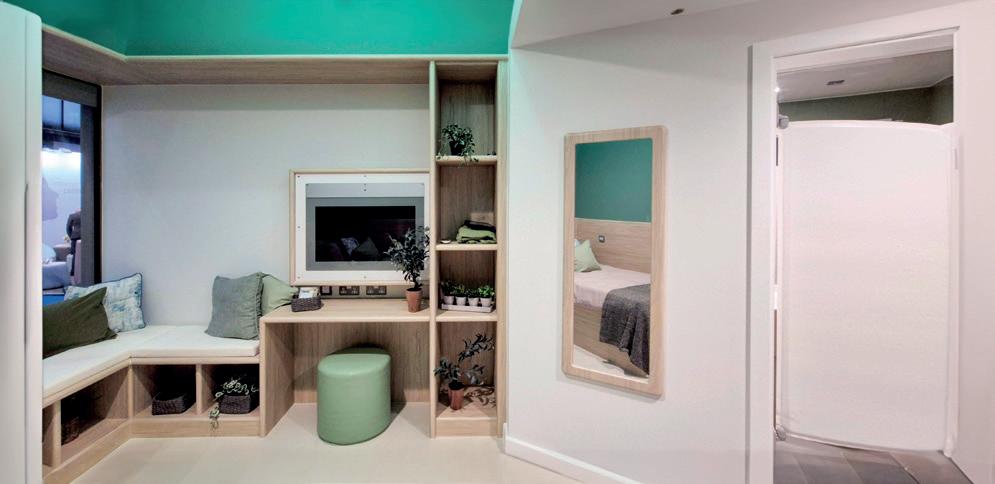


linkedin.com/company/healthcare-property/
bedrooms, and we announce the categories for the 2025 Healthcare



remain confident in the sector, and we explore Assura Plc’s recent acquisition of Northwest Healthcare Properties, plus you can read about all the latest property deals in the sector
The importance of seeking legal advice before embarking on longterm carbon reduction projects within the NHS, plus experts share the top strategies that hospitals can apply to improve waste management

New Health and Social Care Minister, Wes Streeting, has ordered a review of the funding and timetable for the previous government’s £20bn New Hospital Programme (NHP).
Facing questions in the Commons about the Conservative’s pledge to deliver 40 new and refurbished hospitals by 2030, Streeting vowed not to give patients ‘false hope’ about when they can expect moreup-to-date facilities.
He said: “It’s painfully clear that the previous government’s New Hospital Programme, that said they would deliver 40 new hospitals by 2030, is not deliverable in that timeframe.
“I want to see the New Hospital Programme completed, but I’m not prepared to offer people false hope about how soon they will benefit from the facilities that they deserve.
“That’s why I’ve asked officials as a matter of urgency to report to me on the degree to which the programme is funded, along with
a realistic timetable for delivery.”
The New Hospital Programme was announced in 2020 and aimed to build 40 new hospitals in England by 2030.
It was given £3.7bn in capital funding up to March 2025, with more to be provided for the following five years.
The programme is also intended to transform how NHS healthcare infrastructure is built in the future, including by standardising hospital design and embracing offsite construction methods.
But Streeting said he was ordering a review of the programme following major delays and widespread concern that the projects will not go ahead or will be watered down.
And he promised to ‘come back to this House and back to the country with promises that we can keep and promises that the country can afford’.
Responding to news of the review, shadow health minister, Caroline Johnson, told the House the previous government
had prepared to declare two New Hospital Programme schemes complete during the current 2024/25 financial year, with 18 more projects under construction.
And she warned the review would risk delaying much-needed projects, adding: “The Government is now putting this at risk by launching a review of this work, delaying those projects which are of vital importance to patients across the country.”
Tory MP, James Wild, also raised the issue of Queen Elizabeth Hospital, King’s Lynn, in his North West Norfolk constituency, where thousands of props are supporting the building’s roof, and urged the Government to sign off on the business case for a new hospital in the town.
Streeting replied: “When it comes to reinforced autoclaved aerated concrete (RAAC) hospitals, they are top of my list of priorities.
“I’m extremely concerned about the dire state that the NHS estate is in.”
As the new Labour administration seeks to put the future of the NHS at the centre of its policy agenda, the new report acts as an important reminder of the need to think holistically and flexibly about how the NHS is managed

new Secretary of State for Health and Social Care.
Streeting was first elected as MP for Ilford North in 2015 and had been shadow health secretary since 2021.
Before becoming an MP, he served as the deputy leader of Redbridge Council and worked for various charities with a focus on tackling educational inequality.
He takes over leadership of the department from Conservative MP, Victoria Atkins, who had served since November 2023 following a string of new health secretaries over the last three years under the thenConservative government.
Speaking after his appointment, Streeting said of his ambitions for the role: “When we said that patients are being failed on a daily basis, it wasn’t
simple facts, but, in order to cure an illness, you must first diagnose it.
“This government will be honest about the challenges facing our country, and serious about tackling them.
“From today, the policy of this department is that the NHS is broken.
“That is the experience of patients who are not receiving the care they deserve, and of the staff working in the NHS who can see that – despite giving their best — this is not good enough.
“This government has received a mandate from millions of voters for change and reform of the NHS, so it can be there for us when we need it once again.
“It will take time — we never
department, every member of this government, and the 1.4 million people who work in the NHS, to turn our health service around.
“That works starts today.”
He said he was particularly driven to repair the health and care system after suffering from kidney cancer.
He was diagnosed in 2021 after being admitted to hospital with a kidney stone.
After an operation to remove a kidney he later announced he was cancer free.
In his first visit following his appointment, Streeting toured the Abbey Medical Centre in St John’s Wood, London, where he met with, and listened to, staff.
And he declared he will bring
patients can get through the front door of the NHS and access the care they need.
“My first visit as Health Secretary was to a GP practice because when we said we want to shift the focus of the NHS out of hospitals and into the community, we meant it,” he said.
“I’m determined to make the NHS more of a neighbourhood health service, with more care available closer to people’s homes.
“Because if patients can’t get a GP appointment, then they end up in A&E, which is worse for them, and more expensive for the taxpayer.
“We are committed to bringing back the family doctor so patients can see the same doctor each appointment, fixing the front door to the NHS.”
The NHS and social care system historically play a key role in political parties’ election manifestos as they are a priority for most voters.
In the run-up to the General Election, the winning Labour Party set out a number of pledges, including cutting waiting times, doubling the number of cancer scanners, reviving NHS dentistry services, reforming employment support, and re-opening the door to primary care.
And some further detail was provided in the King’s Speech on 17 July, where healthspecific announcements included reforming the Mental Health Act and tackling smoking by raising the age of sale of tobacco products.
The new Mental Health Bill is being drawn up due to criticisms of the current Mental Health Act 1983, particularly around the treatment of black people, as well as those with learning disabilities and autism.

out several changes, including phasing out smoking and introducing further regulation on vaping.
The ban on conversion practices is another proposed reform that is crucial in supporting vulnerable communities, according to the NHS Confederation.
Proposals to give more powers to local authorities and metro mayors also formed a key part of the speech and were welcomed for giving local health and care leaders a key role in local growth policy.
Other key points included:
• Measures in the planned Employment Rights Bill to increase adult social care pay
to address the high vacancy rate and help to attract and retain more staff
• A Cyber Security and Resilience Bill which will close loopholes in outdated existing legislation to protect the NHS and other public services from the devastating consequences of cyber attacks
• Plans to revive measures to restrict advertising of junk food to children, along with banning the sale of high caffeine energy drinks to children
A spokesman for the NHS Confederation said: “The legislative agenda from the speech focused on economic growth, with less health focus than in recent years.
“However, the King stated the Government’s intention to ‘reduce the waiting times, focus on prevention, and improve mental health provision for young people'."
Sarah Woolnough, chief executive of the King’s Fund health think tank, added that there should have been greater focus on social care services, stating: “A central theme of the new Labour government’s first legislative programme is unlocking economic growth, and a strong economy is inextricably linked with a healthy population, supported by a strong health and care sector.
“‘While boosting the workforce would address one of the many issues facing social care, more-fundamental reform of the sector is still needed.
“The social care system in England is not
fit for purpose and the new government now has the opportunity to create a nation where people’s care needs are properly met.
“We hope to see more on their plans to reform adult social care soon.”
She added: “Improving the nation’s health depends on a wide range of measures in areas such as housing, the environment, and employment.
“Cross-government action will be needed to achieve Labour’s stated aim of halving the gap in healthy life expectancy between the richest and poorest regions in England.”
The King’s Speech has also fast-tracked its consultation on the reform of the planning system, which could have major implications for the health and care sector and the property market.
Its proposed Planning and Infrastructure Bill will accelerate the development of infrastructure and the construction of 1.5 million homes.
The pledge to ‘get Britain building’ includes simplifying the planning consent process for significant infrastructure schemes, reducing the bureaucratic hurdles that currently delay project approvals.
It will also modernise planning committees, increasing the efficiency of application processing and facilitating quicker decisionmaking, enabling faster project launches.
Furthermore, the bill focuses on unlocking more sites for development by improving land assembly processes. This includes uniting separately-owned parcels of land.


Nottingham-based contractor, Henry Brothers Construction, has been appointed to build a new £15m centre for community health services in Belper, Derbyshire.
The modern facilities — designed to have high environmental credentials to ensure long-term sustainability — will be built on the site of the former Belper Clinic, as part of the Babington Hospital site in Derby Road, Belper.
Derbyshire Community Health Services NHS Foundation Trust has commissioned Henry Brothers to deliver the new building.
Jim Austin, executive director at Derbyshire Community Health Services NHS Foundation Trust, said: “We are delighted to announce the award of the contract for this project in anticipation of the start of work on site.

"Once completed, this new building will deliver healthcare facilities fit for the 21st Century for people in Belper and surrounding areas.
“It has been a long time in the planning and we’re excited to see site preparations for building work starting soon.”
The health hub will feature 15 consulting rooms, six treatment rooms, a health education group room, and other facilities, and will provide a range of services including community nursing, midwifery clinics, podiatry services, speech and language therapy, physiotherapy, continence advisory service, woundcare, and phlebotomy.
And the development will include environmentally-sustainable features such as photo-voltaic panels on the roof to harness the power of the sun, with pledges to use local and recycled material from demolished buildings where possible, along with timber from certified sources.
Designed by architects Race Cottam Associates, the building will accommodate all existing outpatient and clinical services provided at Babington Hospital.
Ian Taylor, managing director of Henry Brothers Construction, said: “We are proud to have been appointed by Derbyshire Community Health Services NHS Foundation Trust to build this important new community health facility for the people of Belper.
“Henry Brothers has wide experience of delivering community facilities in Derbyshire and beyond, such as schools and healthcare services, and we look forward to starting on site.
“Once completed, the Belper health hub will play an important role in the local community, providing key facilities to residents."
Planning permission for the new community health services hub was granted by Amber Valley Borough Council in September last year, paving the way for the process of inviting tenders and appointing a contractor, procured through the Pagabo Framework.
Enabling work at the site is now getting under way, with a planned construction period of 66 weeks.
It is being built to BREEAM ‘excellent’ sustainability standards.
Other members of the construction team alongside Henry Brothers and Race Cottam Associates include project manager, Capita; civil and structural engineer, Eastwood Consulting Engineers; and mechanical and electrical engineers, EP Consulting.
Care home operator, Yorkare, has opened a new £10m care home in Haxby, North Yorkshire, offering 63 en-suite bedrooms.
Haxby Hall’s facilities include a bar, restaurant-standard dining rooms, full beauty salon and hairdressing suite, cinema, and outdoor terraces on each floor. There are also large gardens and a bowling green.
The home was built by construction firm, Hobson & Porter, and is the eighth project the company has completed for Yorkare since 2015.
Yorkare’s marketing and community engagement manager, Nicola Anderson, said: “We’re delighted to welcome our first residents into their new homes at Haxby Hall and everyone has been blown away by the facilities and overall quality that flows through the entire development.
“Every bedroom is designed to be spacious with superb décor and exceptional interiors. All the ground-floor bedrooms

have doors leading out to private patio areas and our premium suites have their own lounge areas and these are already proving popular with both couples and individuals.
“Yorkare’s whole ethos is about combining safe and luxurious living environments alongside engaging social activities that are delivered by our dedicated care teams, activity co-ordinators, and highly-skilled chefs. Haxby Hall ticks all these boxes and more."
Mark Smee, from Hobson & Porter, added: “We’re very proud to complete our
Bouygues UK has been appointed to design and build the new Ambulatory Diagnostic Centre at West Middlesex University Hospital.
The contract builds on the long-term partnership between the trust, Bouygues UK, and its subsidiaries.
The new five-storey facility will provide diagnostic and treatment services in cancer, renal, and imaging for local residents in Hounslow, Richmond, and Ealing.
It aims to reduce health inequalities, improve patient outcomes, and provide care closer to home, freeing up space in the main hospital for inpatient care. It will also support outpatient care and offer day services for patients.
The project includes five storeys of new build, a rooftop plant, and a small terrace area, while the ground floor will incorporate a new single-storey link corridor to the existing hospital building.
Bouygues UK will be supporting the local community with apprenticeships and work experience placements, working with educational institutions in the area and taking part in local charity initiatives.
eighth project for Yorkare in less than 10 years. Every detail at Haxby Hall, from the grand water fountains in the landscaped gardens to the magnificent communal areas, has been impeccably designed and speaks volumes about the standard of the whole development.
“It’s more akin to a five-star hotel than a care home and there’s no doubt it’s going to be a very special place for residents to live as they start the next chapter of their lives.”
Yorkare now has 12 homes in Yorkshire and Lincolnshire, with five more under construction.

Lesley Watts CBE, chief executive of
Chelsea and Westminster Hospital NHS Foundation Trust, said: “The new diagnostic centre at West Middlesex University Hospital will provide a vital service for our residents, speeding up diagnosis and treatment.
“Most importantly, it will improve early diagnosis and health outcomes for patients in our community for years to come.”
The development is designed to be an allelectric building.
A 35,000sq ft refurbishment to the existing Hollinswood House in Stafford Park, Telford, has been handed over, marking a significant milestone in the provision of community-based health services in Shropshire.
Morris Property has completed a comprehensive interior refurbishment of Hollinswood House, transforming what once served as offices into a new healthcare facility for Shropshire, providing a more-efficient service for the non-urgent needs of patients.
The works were completed in two phases and central to the transformation has been the establishment of Shropshire’s first Community Diagnostic Centre (CDC), boasting cutting-edge medical equipment including a CT scanner, X-ray, and ultrasound, as well as dedicated cardiorespiratory and phlebotomy rooms, all conveniently located on the ground floor.
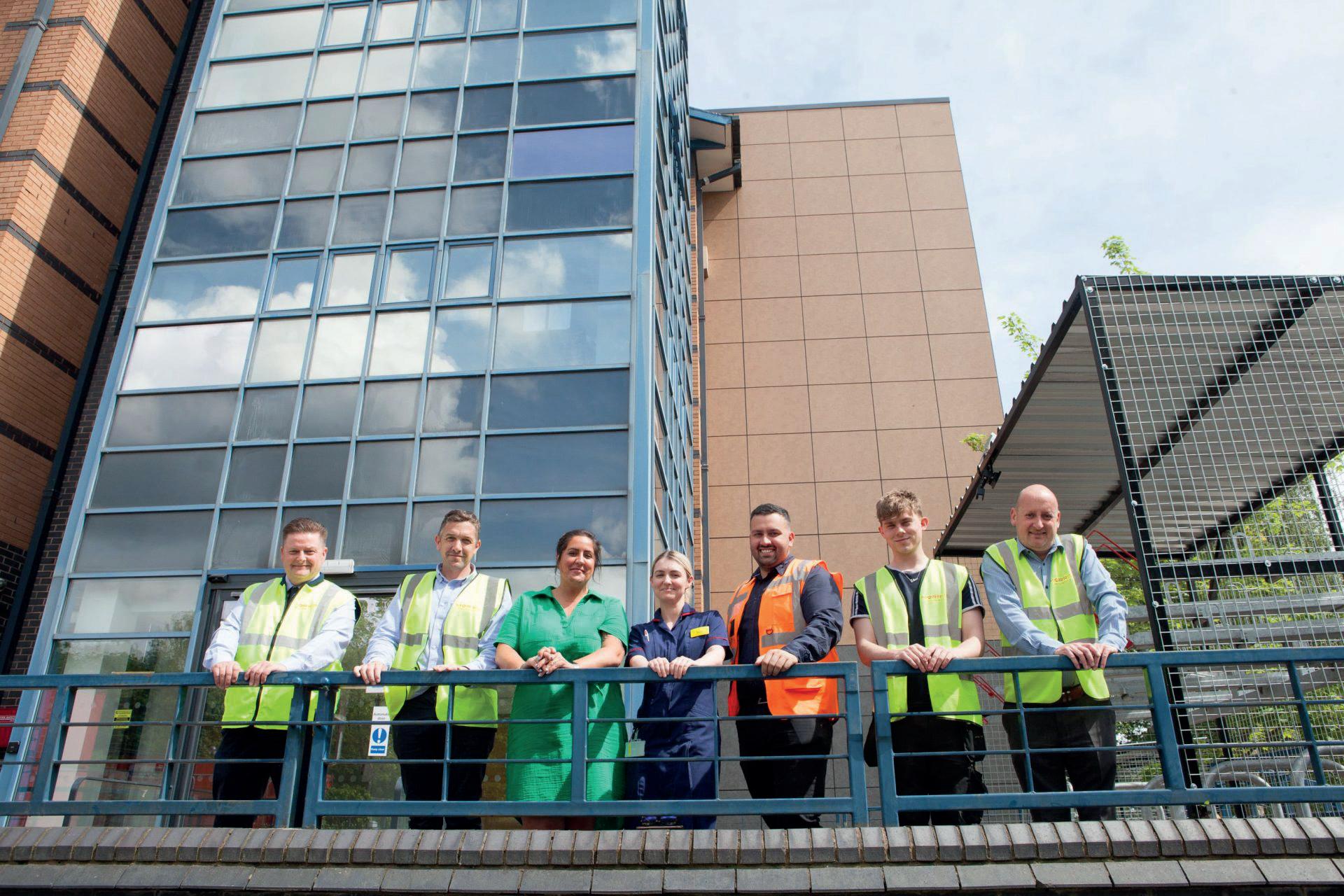
The first and second floors have been repurposed to accommodate a relocated renal service from Princess Royal Hospital, with more than double the previous space.
Both floors also house consulting and interview rooms alongside staff areas on the first floor, while the second floor includes dialysis facilities for lower-risk patients, while also catering for future demand.
The latest phase includes completion of the third floor with dedicated spaces
for cardio-respiratory and dermoscopy departments, complemented by a bespoke reception area crafted by Morris Joinery. Since the inauguration of the Community Diagnostic Centre, more than 13,000 patients have benefitted from streamlined access to routine diagnostic and blood tests, reducing the need for hospital visits and alleviating strain on healthcare resources.
And the CDC continues to grow and develop, with the recent introduction of a
teledermatology service, meaning patients can now access quicker diagnosis and treatment for skin cancer.
James West, chief operating officer at Morris Property, said: “This building project has required us having to work within and around a live building site with ongoing healthcare provision, but through close collaboration with department heads and centre managers, we’ve been able to minimise disruption and ensure the continuity of care in the community.”
Kier has been appointed by the King’s College Hospital NHS Foundation Trust to deliver a new £25m endoscopy building at the Princess Royal University Hospital (PRUH) in Farnborough.
The two-storey, 2,400sq m building will support the delivery of vital health services in the south of London, including the ambition to help an additional 4,500 cancer patients each year.
The new building has been designed to improve the patient experience, with the patient’s journey adhering to accredited pathways set by the Joint Advisory Group (JAG) on Gastro-Intestinal (GI) Endoscopy.
Facilities will include consultation, treatment, and recovery rooms, a sterile services unit, plus rest and training spaces for staff.

David Rowsell, managing director at Kier Construction London, said: “We are delighted to be appointed by King’s College Hospital NHS Foundation Trust to deliver
of experience in delivering first class health facilities to improve the hospital’s infrastructure and help support patient care in South London.”
Work to build a new £20m mental health unit began last week as NHS staff and construction colleagues, along with local people who have lived experience of learning disabilities and autism, watched the first spades break ground.
The new facility will be based in Bristol and will provide care and support for people with a learning disability or autism from across the northern half of the South West region.
It will be able to support up to 10 patients at any one time, with the building specifically intended for those whose needs cannot be met by existing hospital or community-based services.
With the doors expected to open in 2025, the unit will help keep people much closer to home and reduce the need for patients to be admitted to facilities far away from their family and friends.
Among those who witnessed the turf being officially cut was Ben Stunnel, an autism peer mentor whose lived experience, along with that of others with the condition, has helped to influence the design of the new build.
He said: “It has been very
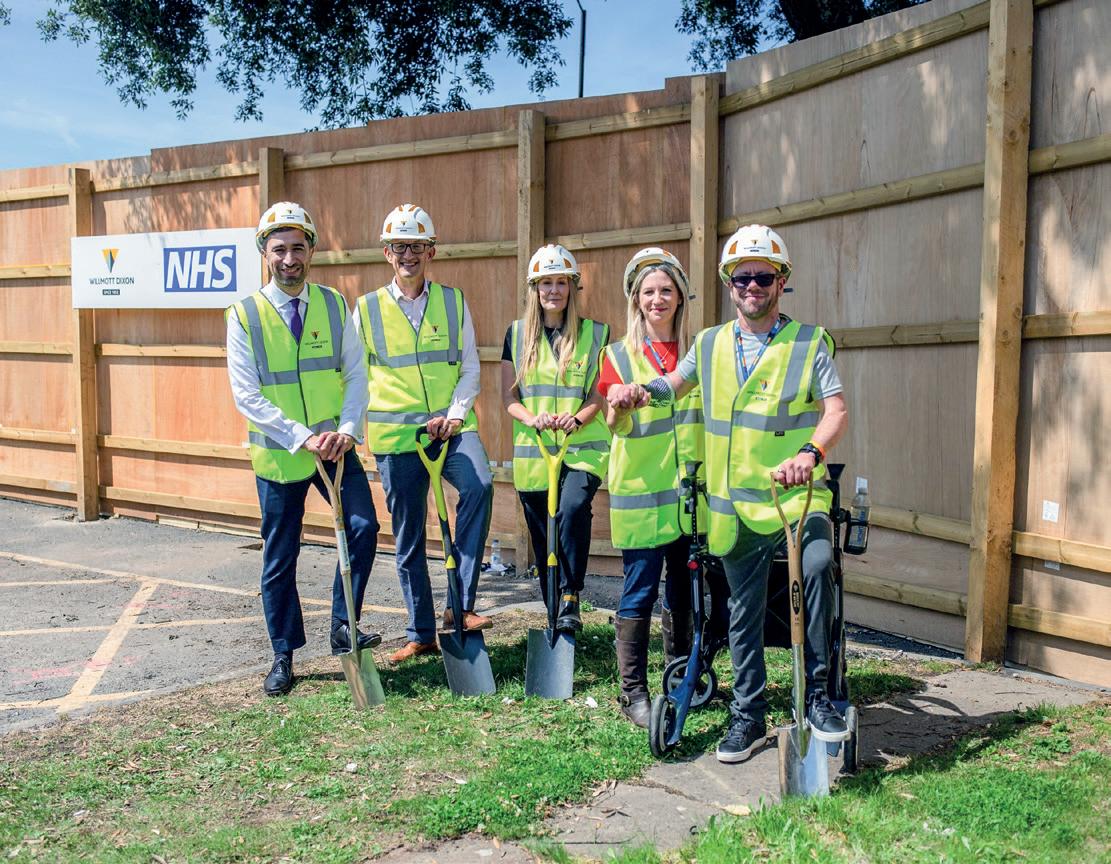
rewarding and confidence building to have our thoughts and ideas listened to and it will be very exciting to see the building going up and taking shape knowing that we’ve contributed so much.
“I really hope that in future many people and families will benefit from what this new building can offer and that it will help to ensure that people get the best care possible to meet their needs and support recovery.”
The new unit, which will be run by Avon and Wiltshire Mental Health Partnership NHS Trust, will complement another similar facility currently under construction in Devon.
Once operational, the two sites

will not only ensure that people from across the South West in need of inpatient care can get the support they require closer to home, but also help, wherever possible, to avoid unnecessary hospital admissions.
Laura Ambler, executive lead for learning disabilities and autism at Bath and North East Somerset, Swindon and Wiltshire Integrated Care Board, said: “I am delighted that after months of rigorous planning and working in partnership with local people and their families, work on this new unit is formally under way.
“When fully open in 2025, this site will be a fantastic addition to our existing mental health services, and I know from speaking with local people
that having something like this based in our region will make an enormous difference to those who may have otherwise needed to have travelled significant distances for the right care and treatment.”
David Jarrett, chief delivery officer for Bristol, North Somerset and South Gloucestershire Integrated Care Board, added: “It is fantastic to see work starting on this much-needed facility.
“Its development demonstrates our shared dedication to delivering specialised, compassionate care that meets the unique needs of local people, ensuring they receive the support and services they deserve.”
Construction of the new unit, which is yet to be named, is being led by Willmott Dixon, with the project expected to complete next spring, ahead of an official opening later in the year.
Avery Healthcare’s latest purpose-built care home, Waterhouse Manor Care Home in Peterborough, Cambridgeshire, has been completed and is awaiting Care Quality Commission approval to open to residents.
The 80-bedroom, three-storey home will provide residential, respite, and dementia care for older people, and includes suites for couples, a lounge, hair salon, café, and therapy facility.
The building forms part of the Hampton Gardens development, which also includes a convenience store, residential accommodation, and a nursery.
Clegg Construction completed a £10.3m contract to deliver the home — the third it has built by for Avery Healthcare. Clegg

previously delivered Middleton Lodge Care Home in Littleover, Derbyshire; and Mousehold View Care Home in Norwich.
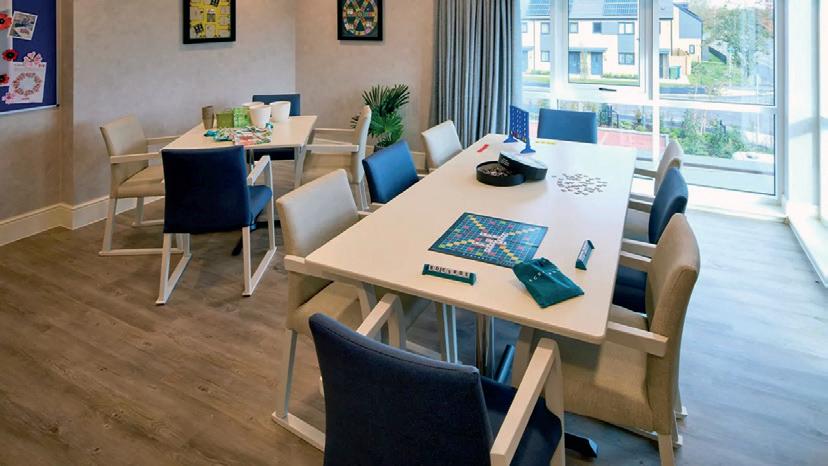
Other members of the project team included Harris Irwin Architects, project manager; quantity surveyor, Holden and Lee; and mechanical and electrical engineer, Harniss.
Avery Healthcare’s director of developments, Adrian Doyle, said: “Waterhouse Manor Care Home is part of an
extensive development programme being undertaken by Avery Healthcare and we are proud that this is the latest in a number of new care homes that will be opening over the next year, with others in Sheringham, Burley in Wharfedale, Downham Market, Eastbourne, and Gravesend all under construction.”




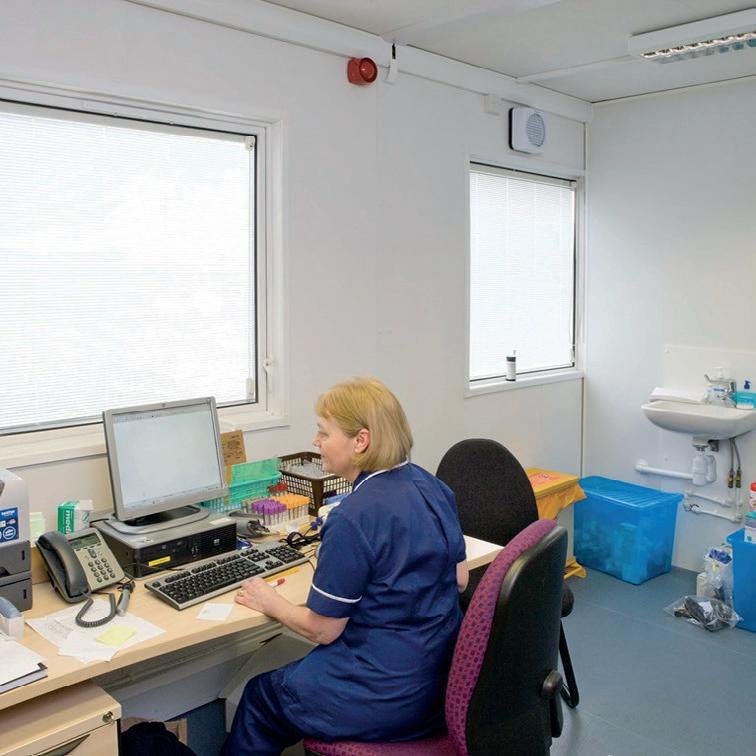
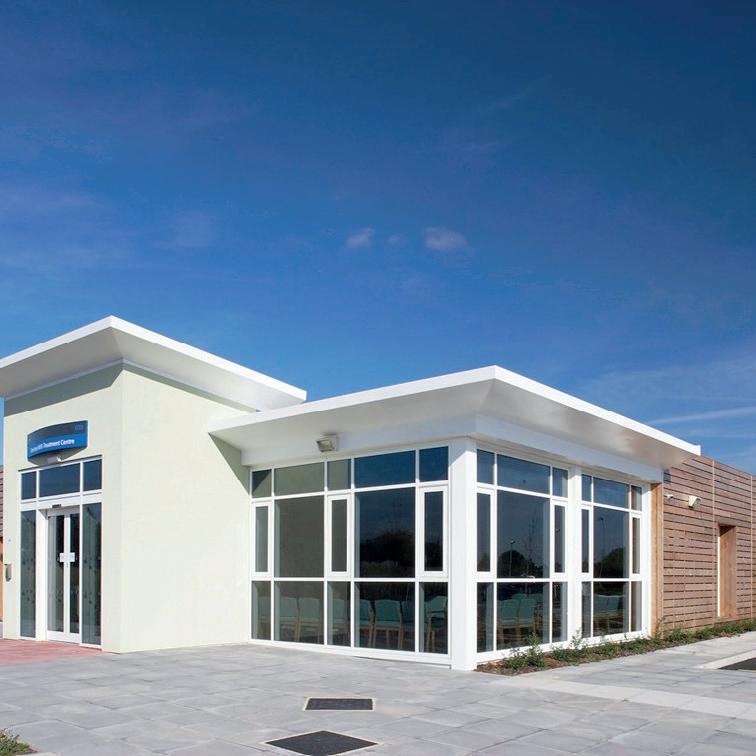
A new report sets out a five-point plan to address the challenges facing the NHS estate
H7.6 million cases can help transform the future of the service and make it secure for the long term, according to a report published today by healthcare facilities experts, Darwin Group and Portakabin.
The report titled Line, commissioned by Portakabin and endorsed by the NHS trust membership organisation, NHS Providers, concludes that the ageing NHS estate, which carries a staggering ongoing maintenance cost of £11bn, can benefit directly from a holistic approach to the patient journey which factors in the use of adaptable clinical and non-clinical buildings to safeguard patient care, safety, and staff support.
These flexible spaces can be added to existing hospital buildings in a matter of weeks, offering an instant solution to enable patients to be seen and treated more quickly.
“Contrary to some beliefs, the safety and quality standards of modular buildings are equal to those of long-standing facilities across the NHS estate,” said

on workforce wellbeing by including a clinical perspective on staff management, a plan to actively consider the adaptability of existing NHS buildings to meet future needs, and a major focus on reducing waste by active planning.
“Waste is one of the most-important problems the NHS needs to address in order to make itself fiscally and operationally sustainable for the long term,” said Dawe.
“The healthcare needs of our expanded population are a million miles from the NHS when it was founded.
“This means creative and lateral thinking is required to meet the current and future needs of the patients it serves.
“The astonishing speed and agility which was shown around the creation of Nightingale facilities during the COVID-19 pandemic is one example of the power of flexible facilities to predict and respond to escalating patient need.
“The opportunity now is to recognise and learn from that experience to fully futureproof our health service in a way that brings down the waiting list backlog and enables all those who work tirelessly inside the NHS to deliver treatment and care without compromising standards.”
According to the report, thinking actively about the adaptability of NHS estates via early engagement and improved collaboration alongside that of clinical strategies as a ‘golden thread’ during capital building projects is among the mostimportant actions in reducing waste during the patient care journey and building the resilience of the service for future generations.
And it concludes that smart ways of planning for capital expenditure can result in a higher degree of NHS sustainability.
The report also makes the case for considering purpose-built facilities designed to optimise resources to be more energy efficient and environmentally conscious, via reducing the number of buildings which are no longer suitable for clinical use and focusing on adaptable strategies which directly impact waiting times and allow patients to be seen, diagnosed, and treated more efficiently.
By doing so, the NHS can not only reduce its impact on the environment, but be more flexible in adapting to the likely future needs of individuals as the UK population continues to age and chronic diseases requiring ongoing management become more common.
“We understand the critical role that estates and facilities play in safeguarding
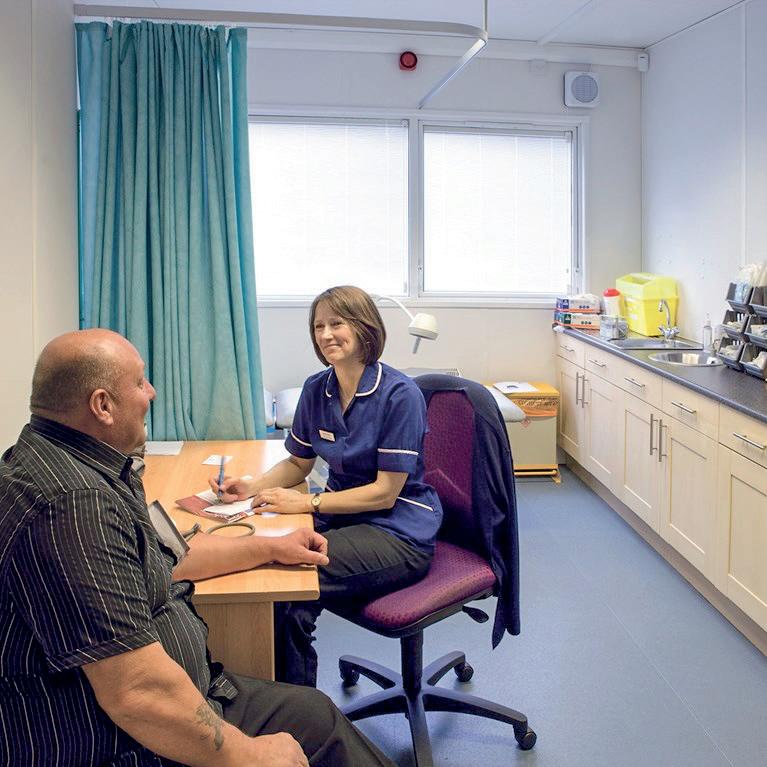

As the new Labour administration seeks to put the future of the NHS at the centre of its policy agenda, the new report acts as an important reminder of the need to think holistically and flexibly about how the NHS is managed
the future of the NHS and its patients,” said Dan Ibbetson, chief executive of Portakabin.
“For this reason, we are proud to launch the Five-Point Plan, The End of the Waiting Line, which has been timed to support the newly-formed Government and health and care colleagues in addressing urgent system priorities.
“To strengthen our healthcare expertise, Portakabin acquired Darwin Group last year, a specialist in healthcare construction with over 18 years of industry experience.
“This partnership has significantly enhanced our combined capacity and speed, enabling us to deliver high-quality clinical and non-clinical buildings swiftly to
meet immediate NHS needs.
“Together with the teams at Portakabin and Darwin Group, I stand with our health and care colleagues as they navigate the ever-changing landscape of care.
“And we look forward to welcoming supportive and decisive action from the country’s leadership to protect and safeguard, not only the future of the NHS, but also the safety of its patients and workforce.” n
The full End of the Waiting Line report can be accessed at https://contact. darwingroup.co.uk/ five-point-plan-review
The astonishing speed and agility which was shown around the creation of Nightingale facilities during the COVID-19 pandemic is one example of the power of flexible facilities to predict and respond to escalating patient need
A national planning and development consultancy has called for the Labour government’s review of national planning policy guidance to provide clarity to local planning authorities (LPAs) on how they can develop tailored local policies to support investment and growth at developed sites within the Green Belt.
Following Chancellor Rachel Reeves’ recent announcement regarding Green Belt development, Lichfields’ report highlights the potential economic and social benefits of planning reform.
In new research, it refers to the inherent challenges posed by current national Green Belt policy guidance that could stifle, or at least delay, investment and undermine the ability for existing organisations to improve their facilities, remain competitive, and continue delivering a range of important services.
The Major Developed Sites in the Green Belt — The Land That Policy Forgot? report reveals that a portion of the Green Belt, which covers approximately 12.6% of England’s land area, could be developed for a range of uses including hospitals and other medical institutions.
The report explains that pre-2012 national policy used to recognise many of these locations as Major Developed Sites (MDS) and provided clearer guidance on how LPAs should assess development proposals. However, this was removed by the 2012 National Planning Policy Framework (NPPF).
This established more-subjective, generalised guidance, stripping out the detail around how an LPA could approach the identification, definition, and guidance of development at such sites in local plans, potentially limiting the ability of these sites to evolve and contribute to local economies and services.

Ian York, a planning director at Lichfields and co-author of the report, said: “Our research shows that the majority of LPAs are adopting generalised policies that repeat national
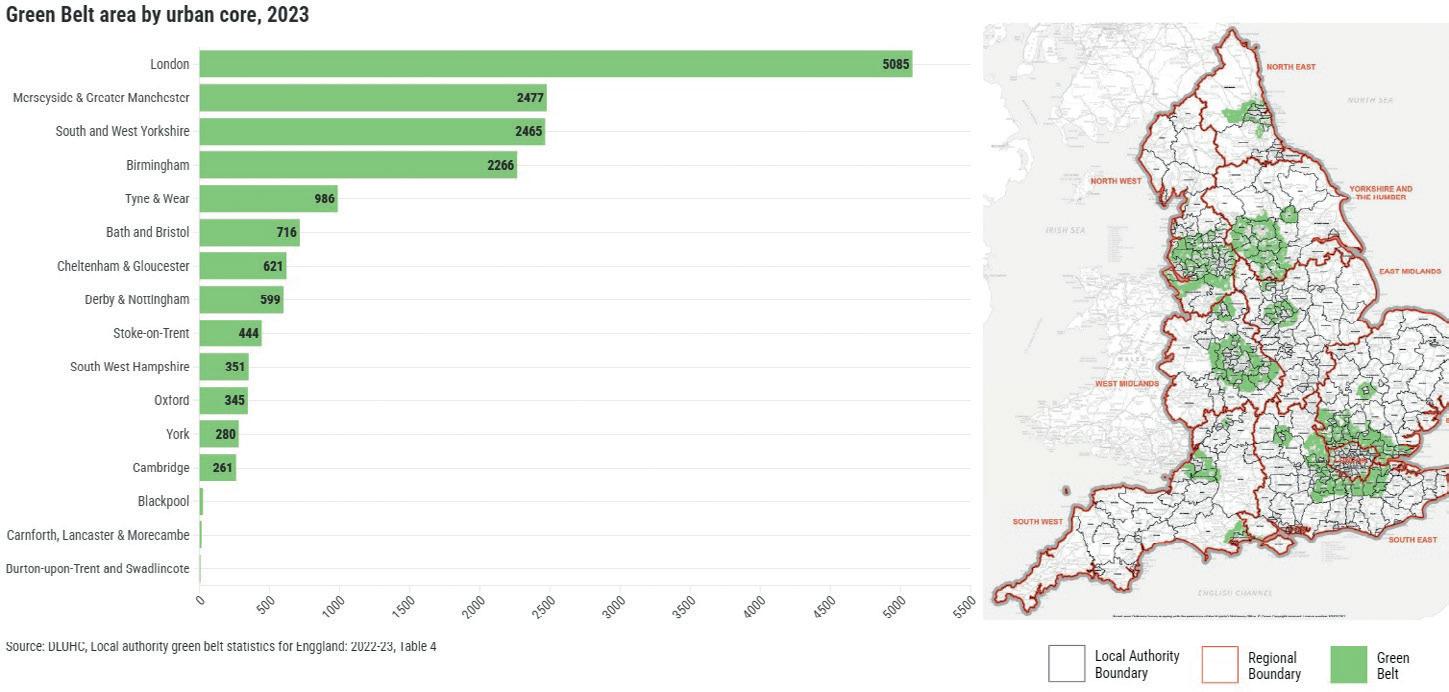
“We must move away from a one-size-fits-all approach and adopt local, bespoke policies that recognise the unique characteristics of these sites.
“The report urges LPAs to engage with landowners and operators to create detailed policies that clearly define development parameters, ensuring these sites can thrive without compromising Green Belt integrity.”
The research shows that of the 180 LPAs with Green Belt land, only a third have adopted criteria-based, bespoke policies, while two thirds default to generic NPPF guidelines.
This local policy context means less certainty for owners and operators to plan for the future of their sites where there is a continuous need.
Furthermore, there is a regional disparity in the policy approach, with the North West of England having the highest reliance on generic NPPF-based Green Belt policies and the South East of England leading in bespoke approaches.
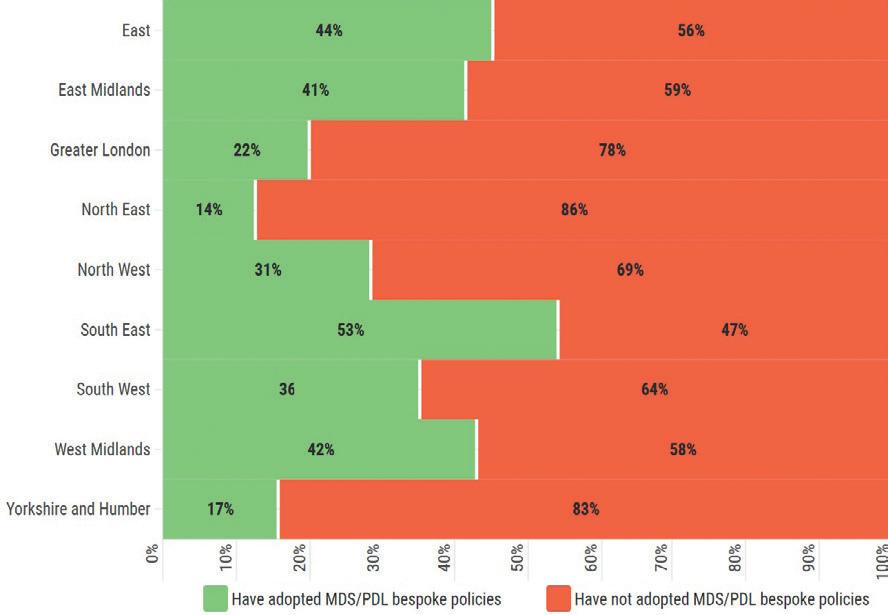
York said: “National Government has a very-important part to play.
“With the new Labour government’s commitment to updating the NPPF within its first 100 days, there is a crucial opportunity to reintroduce policy guidance akin to the previous MDS framework.
“This will provide much-needed clarity and support for LPAs and developers alike.”
And Lichfields urges policymakers to consider these recommendations seriously.
“Tailored local policies are essential to unlocking the full potential of developed Green Belt sites, enabling them to significantly contribute to local economies, enhance community services, and support sustainable growth across the UK,” said York.
The Government’s consultation on changes to the policy will end on 24 September. n



Knight Frank has released its Healthcare Capital Markets – 2024 report. Here, we look at the key findings and why property experts remain confident in the sector
Demographics, long-term income, and ESG credentials ‘present an undeniable case’ for investment in the healthcare property market, according to a new report from Knight Frank.
The Healthcare Capital Markets — 2024 report provides an annual assessment of the latest investment trends and performance in the UK healthcare property sector.
It focuses on emerging trends from both an operational and real estate perspective and dives into the sentiment of investors to understand the state of the market by surveying most key UK market players including major REIT, institutional, and overseas investors to gain a comprehensive insight of the current state of the sector.
Ryan Richards, associate for commercial research at Knight Frank, said:
“Unsurprisingly, UK healthcare markets have felt various pressures over the past year. However, a broader lens ultimately shows this to be more of a real estate trend than a healthcare one.
“Despite this, the sentiment remains positive, and the view is that healthcare’s fundamental drivers, such as demographics, long-term income, and ESG credentials, present an undeniable case.”
He added: “2023 carried on 2022’s trend of general uncertainty, with investors stepping back to gauge markets; and we saw recorded volumes close at circa £1.2bn.
“We did, however, see the continued
movement towards normality in operator trading.
“This, in line with improved operator trading in our annual Care Homes Trading Performance Review, is a welcome boost to sector confidence.
“Overseas capital dipped again this year, accounting for 25% of transactions, down from 31% and even further from its longterm average.
“Average annualised returns sat at 4.4% at the end of Q4 2023, up from 3.50% in the previous period. This, as always, highlights the healthcare sector’s strength in terms of stability of returns.
“The overall outlook for the healthcare sector is undoubtedly positive, with key market participants already transacting in Q1 2024.”
Knight Frank’s Attitudes Survey highlighted that healthcare ranked as the second leading sector, with 13.2%, just slightly behind the living sector’s 13.8% in terms of investor demand.
More interesting is that the living sectors demand comprises PRS, senior living, and student, suggesting that healthcare remains a standout choice on an absolute basis.
Factors driving the sector’s popularity among investors include:
• Demographic shift: In the UK the over-85 population is set to increase from 1.7 million to 3.7 million by 2050. An ageing population means increasing demand for residential care, primary care, and acute hospital services
• Long-term income: Weighted average unexpired lease terms average 25-30 years in the residential care and hospital sectors. And leases are commonly index linked to inflation
• Secure income: Operator revenue is reinforced by a healthy mix of self-funded care and publicly-funded care. Income is supported by high occupancy and patient demand across the healthcare arena
• Investment performance: Total returns measured 4.4% in 2023, higher than many core property sectors. And returns are historically stable, offering investors protection and diversification
• Structural change in real estate: Real estate investors are already derisking from traditional sectors such as retail into alternatives like healthcare
• Demand for safe havens: Broader UK real estate offers security and liquidity in a global downturn. UK healthcare’s longterm and often government-supported income offers further defence
• Social impact: The influence of impact or ESG investing in real estate is growing at a faster pace than ever. A range of investors are now focusing on social infrastructure investments, and healthcare is part of this The resilience of the healthcare sector and its lack of sensitivity to wider economic shocks is further illustrated when comparing the annual movement in healthcare volume to that of all property classes.
According to the report, healthcare, which accounted for around 3% of all commercial property transactions, has historically seen a trend of growth in transaction volumes, despite a slight dip in volume experienced by all property classes this year.
Further highlights of the sector’s consistency can be seen when assessing
We
transaction volumes on a quarterly basis.
“A key trend emerging from this data is the lack of spikes from outlier transactions, which results in smooth volumes between quarters,” the report states.
“This suggests we are experiencing a more-sustainable and normalising level in healthcare real estate demand.
“Investment by sub-sector is another area to consider when discussing market volume.
“Elderly care continues to generate the most interest from investors on all fronts, accounting for 83% of volume. In addition,
adult care took some share of the reported volume, accounting for 11%.
“Notably, of this demand in elderly care, there is a circa 80/20 split between investment and occupier deals respectively.
“It continues to be helpful to understand where capital is being placed and how this differs from historic investing trends.”
When quizzed on the biggest issues with the current quality of real estate stock, respondents cited size (8%), lack of en-suite facilities (17%), lack of a full wetroom (25%), ESG credentials (42%), and scope
for repurposing (8%).
And 33% thought the current pricing tone of the market was too high.
In particular, private hospitals demonstrated strong operational resilience in 2023, despite the impact of cost inflation (wages and energy prices) and rising interest rates.
Top-line performance has been supported by the growing NHS backlog fuelling demand from the public sector for private sector capacity; growth in the self-pay market; and higher levels of Private Medical Insurance (PMI) as patients seek alternative ways to reduce the waiting period for treatment.
In the report, Nicholas West, UK head at Northwest Healthcare Properties REIT, said: “We are seeing an emerging trend of private operators reinvesting profits into major capital expenditure projects at their hospitals, such as construction of new operating theatres, upgrading of diagnostic equipment, and other building fabric improvements.
“For example, in 2023 Spire undertook £2.8m of capital expenditure to repurpose admin space to a new minor operations theatre at its asset in Sheffield.
“We anticipate that these improvements will boost operator profitability and energy performance credentials going forward.”
And he said location was key to the operational performance of a hospital.
While 2023 presented as a slow year, there is a silver lining in the fact that this was a trend present across global real estate, and with 2024 starting on a much-more-positive note, we are optimistic for the year ahead
“Access to top-quality consultants, proximity to NHS feeder sites, and patient affluence profiles are some of the key criteria which are important to hospital operators,” said West.
Harry Hyman, non-executive chairman of Primary Health Properties, adds that the primary care sector continues to face challenges.
He says in the report: “Development in the primary care space continues to face headwinds as yields have softened and build cost inflation has put significant upwards pressure on the rental levels required to enable scheme viability.
“As a result, the modernisation of the primary care estate which is so crucial to the delivery of the NHS strategy — by allowing much more care to be carried out of the hospital environment — is under significant threat with many new schemes being lost to alternative land uses.
“The challenge now rests on progressing the rental tone in the sector, which is improving, but has a long way to go to achieve viability given the long period of benign rental growth experienced until recently.”
The report concludes: “While 2023 presented as a slow year, there is a silver lining in the fact that this was a trend present across global real estate, and with 2024 starting on a much-more-positive note, we are optimistic for the year ahead.
“The sector’s fundamental drivers remain strong, and investors are seemingly aware of this, with a number of standout transactions already completed or pipelined for completion this year.
“The sector remains well capitalised, which, in addition to robust operator trading and the underlying drivers we have mentioned, suggests that healthcare is in a strong position for the long run.” n
To download the report in full, scan the QR code, or visit https://content.knightfrank.com/research/105/documents/en/ healthcare-capital-markets-2024-11301.pdf
Digital bank, OakNorth, has provided a £26.4m loan to newly-launched and Matter Real Estate-backed developer/ operator, Untold Living.
Founded in 2022, Untold Living is a newly-established developer, owner, and operator of Integrated Retirement Communities (IRCs) across England.
Untold’s mid-market offering bridges the gap between high-end later living properties and housing associations by providing an affordable product that extends the IRC model to as many people as possible.
The IRC service offering itself sits between the more-traditional care home and retirement housing models, offering a community designed specifically for those in later life that adapts to the needs of residents as they grow older.
Having acquired its first site in Westbury,
Wiltshire, Untold currently operates one scheme with several more in the pipeline.
The company is backed by London-based real estate investment firm, Matter Real Estate, whose partnership is helping the business’s ambitious plan to build a large portfolio of retirement villages over the coming years.
The recent £26.4m loan from OakNorth will be used to develop Untold’s 77-unit IRC in Newport, Shropshire, which recently achieved planning consent, as well as support the operations of its existing 68-unit Chantry Court site in Wiltshire.
Untold Living is actively seeking to acquire other suitable sites and assets across the UK to expand its portfolio and is open to discussions with landowners, landlords and agents, targeting a GDV of £300m for its initial development pipeline.
Russell Jewell, chief executive, said: “The
Property investors are cautiously optimistic and focusing on the prospect of base rate cuts ahead of UK and global political issues, according to a new study.
Handelsbanken’s latest Property Investor Report, based on exclusive insights from UK property investors with an average of 35 properties each, found more than half (52%) say the prospect of a rate cut in the coming days, and potentially a further cut before the end of the year, makes them more optimistic about the market.
That is partly reflected in the easing of signs of tenant stress — with around 53% of those questioned reporting issues of rental deferral/contract negotiations, compared with 60% in Handelsbanken’s 2023 report. And the number experiencing overdue or late payments fell to 34% this year compared with 41% in the previous year.
Despite the drop in reported tenant stress, void periods have increased. 60% of the panel reported an increase in voids, up from 54% in the previous year, although Handelsbanken believes this may be partly driven by tenant demand for quality and EPC ratings.
Polled ahead of the General Election, the panel reflected wider market sentiment on the impact of a change in government, with the majority (51%) saying it would not affect

plans for their business.
Around two fifths (40%) said geopolitical uncertainty made them more positive about the UK property market, while 44% said it had no impact.
Handelsbanken commissioned the research in March this year through independent company, Pure Profile. Around 28.5% classified their business
UK’s retirement community sector is no longer in its infancy, but it still has many lessons to learn.
“Our approach has been to learn from best practice not only in the UK, but in countries such as the US and New Zealand, where the market is much more mature.
“As such, our focus has been on ensuring Untold Living’s developments have a thriving culture where residents are engaged, a low affordability barrier that democratises the product, and a flexible approach to amenities.
“We feel this is key to broadening access to the sector, which will ultimately reduce strain on the NHS, ease public finances, and enable our elderly citizens to live longer, more-fulfilled lives.”
Alantra, led by Bobby Fletcher and Danilo Bardella, acted as exclusive financial advisor to Matter and Untold on the transaction.
as real estate investment, while 33.5% classified their business as property management, and 38% classified their business as landlords (residential or commercial).
Of those, 8.5% owned healthcare properties.
Simon Bradley, chief credit officer at Handelsbanken, said: “There is cautious optimism around the property market and activity among existing investors is picking up.
“It may be that many have decided the economy has potentially reached the top of the interest rate cycle and that the time is right to engage in new deals.
“We are seeing many of our Handelsbanken property professionals already looking to increase their credit lines in anticipation of potential acquisitions as market rates soften and property values stabilise over the coming months.
“The report also shows signs of tentative improvements in the stress factors affecting tenants, which have been driven in recent times by the cost of living and energy crises.
“However, most respondents appear unaffected by potential political uncertainty and don't believe that a change in the party in government will lead to significant changes in the market.”

A total of 75 entries have been selected by a panel of esteemed judges to move forward to the finals of the annual competition, which celebrate the very best in seniors housing across categories including advisory, development, innovation, and more.
Organised by Healthcare Property publisher, Nexus Media Group, the winners in each category will be announced at a ceremony at the Grosvenor House Hotel in London on 24 September. To find out more, or to book your ticket, visit https://seniorshousingawards.com
FULL LIST OF THE FINALISTS FOR 2024
IRC SCHEME OF THE YEAR
(Sponsored by Octopus Real Estate) FINALISTS
• Adlington Retirement Living
• Audley Villages & Balfour Beatty
• Belong Villages
• Inspired Villages Group
• Jewish Care
• Richmond Villages
• Siddington Park – Rangeford Villages
• The Shires – MBTHA RETIREMENT HOUSING SCHEME OF THE YEAR FINALISTS
• Audley Villages
• Augustinian Care – St George’s Park
• Brio Retirement Living
• The Hawthorns Braintree
BEST PIPELINE OF THE YEAR
(Sponsored by Knight Frank) FINALISTS
• Adlington Retirement Living
• Birchgrove
• Inspired Villages Group
• McCarthy Stone
• Octopus Real Estate and Pension Insurance Corporation
• Rangeford Villages
INVESTOR OF THE YEAR (Sponsored by Silbury) FINALISTS
• LSM Capital
• Octopus Real Estate

FINALISTS
• CBRE
• Christie & Co
• JLL
LENDER OF THE YEAR FINALISTS
• Beaufort Capital Management UK
• Cain International
• OakNorth
• Octopus Real Estate
• Silbury Finance
LEGAL ADVISOR OF THE YEAR FINALISTS
• Bevan Brittan
• Browne Jacobson
• Gowling WLG
• Irwin Mitchell LLP
• Lester Aldridge
• Pinsent Masons
• Trowers & Hamlins
ARCHITECTURE & DESIGN OF THE YEAR
(Sponsored by Third Age Design in conjunction with Wissner-Bosserhoff) FINALISTS
• Carless + Adams
• ColladoCollins Architects Ltd
• Gaunt Francis Architects and Bernard Interiors Ltd
• Pollard Thomas Edwards
• PRP
• Whichelo Design Studio
• Knight Frank
• Savills
• SAY Property Consulting
• Whiteley Consulting Ltd PLANNING CONSULTANT OF THE YEAR FINALISTS
• DLBP Ltd
• DLP Planning Ltd
• Montagu Evans LLP
• Tetlow King Planning
BEST HOSPITALITY PROVIDER / RESTAURANT OF THE YEAR FINALISTS
• Auriens
• Country Court Care Homes
• LifeCare Residences
• Rangeford Villages
BEST HEALTH AND WELLNESS SERVICE OF THE YEAR FINALISTS
• Aura Care Living Ltd
• Auriens
• Belong Villages
• Brio Retirement Living
• Jewish Care
• Riverstone

• Country Court Care Homes
• Cubigo & Elysian Residences
• Porters Care Limited
• Symphony Hearing & McCarthy Stone
• The Joy Club
BEST PARTNERSHIP OF THE YEAR
(Sponsored by Gowling WLG) FINALISTS
• Audley Villages & Balfour Beatty
• Audley Villages and Royal London
• The Together Project CIO
• Grands Prix
OPERATOR OF THE YEAR
(Sponsored by Lester Aldridge) FINALISTS
• Adlington Retirement Living
• Audley Villages
• Birchgrove
• Jewish Care
• McCarthy Stone
• Retirement Villages
• Riverstone







In this article we explore Assura Plc’s recent acquisition of Northwest Healthcare Properties and how it signifies growing interest in the healthcare property market

The board of Assura plc has announced it has agreed with Northwest Healthcare Properties to acquire its fully-operational UK private hospital portfolio comprising 14 assets for a consideration of £500m.
The deal will be fully funded through a mix of cash and shares including:
• 245,298,262 or c.£100m of consideration shares issued to Northwest on a 30-day VWAP basis and subject to a six-month lock-in agreement
• £266m of debt, which has been refinanced through a new term loan
• £134m using £54m of cash and drawing down £80m from the group’s existing revolving credit facility
Assura believes there is significant opportunity in the structurally-supported private hospital market, with strong growth potential and attractive investment characteristics, as outlined at its Capital Markets Event in February.
All three strands of private (PMI, selfpay, and NHS-referred) are experiencing growing demand, with the private market providing essential capacity to local healthcare infrastructure.
Assura will capture these opportunities given its long-term relationships in healthcare, its development and asset enhancement capabilities, and focus on social impact and sustainability.
The acquisition significantly accelerates Assura’s strategy to diversify into new sectors at scale by adding high-quality, fullyoperational assets in the private market spread across the UK at an attractive price.
It also brings with it a number of financial benefits including earnings enhancement, long-term, secure, and growing income through index-linked reviews and supports a covered and progressive dividend policy.
As a result of the acquisition, Assura is uniquely positioned in the UK as a diversified healthcare REIT.
• The acquisition comprises Northwest’s entire UK portfolio of 14 fullyoperational private hospitals with an average of 36 registered beds per hospital
• WAULT of 26 years, rent roll of £29.4m, yield on cost of 5.9%, and day one rent cover of 2.3 times
• Assets located across the UK, with 64% London weighting based on latest current passing rent
• Estimated rental value of £30.2m, 3% above passing rent based on latest estimated rental value as of December 2023
• All assets annual index-linked rent reviews (60% to RPI and 40% to CPI), capped and collared, typically at 4% and 1% respectively
• All acquired properties feature fully tenant repairing and insuring (FRI) leases, resulting in limited incremental overheads

• Tenant base mostly comprising tier 1 private operators, including Nuffield Health, Circle, and Spire, with 92% at ‘Good’ or ‘Outstanding’ Care Quality Commission rating
The acquisition offers a number of strategic benefits including:
Accelerating Assura’s ability to realise attractive investment characteristics of structurally-supported private healthcare market.
- The addition of a private hospital portfolio valued at over £500m represents a material expansion into the private health market in line with Assura’s strategy, cementing its position as the leading listed UK healthcare property investor and developer
- Assura aims to be the partner of choice for the NHS primary care estate and the target portfolio, combined with its existing exposure to Ramsay Health Care UK and HCA International, will enable the company to access significant relationships with all Tier 1 healthcare providers operating at scale in the UK
- Socio-demographic drivers in the UK, and an NHS system that remains under considerable strain, are leading to growing
demand across all three strands of private health (PMI, self-pay, and NHS referred services)
- Private hospitals typically benefit from long lease lengths of 25-30 years with indexed rents let to long-established operators
Complementing Assura’s existing strategy and sector expertise to make it the ideal estates partner to the private health sector.
- The target portfolio is fully aligned with Assura’s aim to generate attractive financial and social returns for its shareholders and wider stakeholders by investing in, developing, and managing high-quality, sustainable healthcare buildings that provide crucial infrastructure for their local health economy
- Being a socially-responsible owner remains at the core of what Assura does and the private hospital sector is an increasinglyvital component in the UK’s healthcare landscape
- Development and asset enhancement capabilities: the target portfolio includes opportunities for asset enhancement including extensions, reconfigurations, and upgrading the sustainability performance. Assura already has proven development capabilities in the private space, having recently completed several
schemes for Ramsay as well as
Acquiring an attractive portfolio of highquality assets.
- The target portfolio acquired at an attractive price relative to most-recent valuation
- Long average lease length of 26 years — extends proforma WAULT from 10.8 years to 13.0 years
- Rent reviews 100% index-linked with all assets subject to annual reviews; 42% of pro forma portfolio subject to indexed or fixed-basis rent reviews
- Strong underlying tenant covenant complementary to the existing Assura private tenant mix, with 96% of target portfolio rent from Tier 1 private operators and day one rent cover at 2.3 times
- Excellent patient mix at each site reflective of local demands
- 64% of target portfolio exposed to London market which has heavier PMI and self-pay weighting, supporting rental growth and asset values
- Remaining regional sites providing additional capacity for local NHS needs

Improving short and long-term Group financial profile.
- Additive to existing net rental income profile with proforma Group rent roll growing from £149m as to 30 June 2024 to £179m (c.20% increase)
- Earnings accretive in the first full year and will enhance earnings in the medium term with rents efficiently flowing through to earnings
- Significant future growth potential from a supportive rental backdrop for private hospitals and incremental asset management and ESG opportunities
- Proforma LTV of 48%, within policy range of 40-50% with intention to reduce LTV to below 45% and target net debt to EBITDA below nine times over the next 18-24 months
- Balance sheet strength has allowed refinancing of debt at attractive rate
- Assura will maintain a covered and progressive dividend policy
Assura recently announced a joint venture with Universities Superannuation Scheme Limited to support investment in essential NHS infrastructure.
This, along with the acquisition, will see group property value increase to £3.2bn. In addition, the issuance of consideration shares will ensure Assura continues to
This represents a unique opportunity to participate in the growing demand for private healthcare services to help ease growing NHS waiting lists amid the ongoing UK healthcare crisis
maintain leverage within the stated LTV policy range of 40-50%, with proforma LTV of 48%.
Over the following 18-24 months, Assura intends to strengthen the balance sheet by targeting LTV to below 45% and net debt to EBITDA below nine times through the use of third-party capital and a disposals programme which will include a mixture of portfolio and individual asset disposals.
Assura has refinanced the £266m debt through a new term loan provided by Barclays Bank PLC.
Key terms of the loan include:
• 110bps margin above SONIA
• Matures August 2026
• Option to extend by two additional oneyear periods
• Interest rate swap to be taken out for full two-year period with expected rate of c.4% The loan is repayable at any point at Assura’s discretion, with no break costs.
And the proceeds from the aforementioned disposal programme will help to reduce net debt over the next 18-24 months.
As a result, Assura’s debt maturity profile is tightened from a weighted average maturity of 5.75 years as of 30 June 2024, to 5.3 years for the pro forma group, with weighted average cost of debt increasing from 2.30% to 2.99%.
Assura has been in full engagement with rating agencies with respect to the acquisition.
As part of the consideration for the acquisition, applications have been made to the Financial Conduct Authority and to the London Stock Exchange plc for 245,298,262 new ordinary shares of 10p each in the issued share capital of Assura to be admitted to the premium listing segment of the Official List of the FCA and to trading on the main market of the London Stock Exchange.
Admission became effective and dealings commenced at 8am on 9 August.
Following admission, the company will have 3,236,951,244 ordinary shares of 10p each in issue.
There are no shares held in treasury. Therefore, following admission the total number of voting rights in the company will be 3,236,951,244 and this Voting Rights Figure may be used by the company’s shareholders as the denominator for the calculations by which they will determine if they are required to notify their voting rights interest, or a change to that interest, in the company under the FCA’s Disclosure Guidance and Transparency Rules.
Commenting on the deal, Jonathan Murphy, Assura chief executive, said: “The acquisition of Northwest’s high-quality UK private hospital portfolio accelerates the delivery of our broader healthcare strategy, securing increased exposure to the structurally-supported private healthcare market as we continue to diversify our offering in line with UK healthcare demands.

Jonathan Murphy
sustainable long-term top-line growth to underpin a covered and progressive dividend policy.
“The acquired portfolio — with long average lease length of 26 years and indexlinked rent reviews — complements our existing assets and will benefit from our sector relationships, development, and asset enhancement capabilities as the leading listed UK healthcare property investor and developer.
“Expected to be earnings accretive in the first full year, the transaction offers attractive financial benefits including
“While the strength of our balance sheet has supported refinancing at an attractive rate, we intend to reduce our leverage in the next 18-24 months via a targeted disposal programme.
“The portfolio’s diversified occupier base, combined with our existing private occupier mix, means we now have relationships with all Tier 1 private healthcare providers.
“This represents a unique opportunity to participate in the growing demand for private healthcare services to help ease NHS waiting lists amid the ongoing UK healthcare crisis.”
This worsening crisis is driving increased demand for healthcare infrastructure including private health estates, and today’s acquisition positions us as the clear leader in this sector of the market
Ed Smith CBE, Assura chairman, added: “The UK healthcare crisis is getting more severe with each year, a point well recognised by the incoming Labour Government.
“This worsening crisis is driving increased demand for healthcare infrastructure including private health estates, and today’s acquisition positions us as the clear leader in this sector of the market.
“We are now better positioned than ever to use our expertise and capital to help support the NHS and the country’s wider healthcare market as together we address the health challenges of the modern day.”
And Craig Mitchell, Northwest chief executive, said: “These high-quality assets represent significant future growth potential buoyed by favourable healthcare market dynamics in the UK and Assura’s sector-leading position, long-term relationships, and expertise in asset management, development, and enhancement.
“Our conviction in Assura and its strategy is evidenced by Northwest taking an equity stake in Assura as part of this transaction, allowing us to benefit from its future success.”
Assura was advised by Barclays Bank PLC, CMS (corporate legal), and Addleshaw Goddard (finance legal). n
McCarthy Stone¸ a developer and manager of retirement communities, has acquired a development site in Cowbridge, South Glamorgan, from property firm, Mercian Developments.
McCarthy Stone submitted and secured planning consent for a scheme of 50 retirement living apartments with communal facilities.
Leah Tattersall, land manager at McCarthy Stone, said: “It is great news to complete on this site acquired from Mercian Developments after successfully securing a first-time planning consent.
“We very much look forward to bringing more high-quality retirement living homes to South Wales.”
Chris Towers, managing director of Mercian Developments, added: “This strategically located site will bring forward the redevelopment of a former farmstead, which will be regenerated to deliver new retirement apartments for the elderly

residents of Cowbridge and beyond that will integrate well within the local community.”
Business property advisor, Christie & Co, facilitated the sale.
Jordan Rundle, director and head of healthcare development at Christie & Co, said: “According to the ONS, as of 2021 the total population in Wales was circa 3.1 million, with those aged 65 years and over accounting for circa 21%, equating to
approximately 650,000 people.
“Consequently, there is a significant opportunity for developers and operators to provide much-needed futureproofed laterliving accommodation in the country.
“McCarthy Stone’s high-quality retirement living scheme in the desirable market town of Cowbridge is another example of increased development activity we are now seeing as a trend in Wales.”
The site was sold for an undisclosed price.

Care home operator, Lovett Care, has secured a £65m revolving credit facility from real estate investment company, Cain International. The facility will finance a pipeline of new care homes across the UK, starting with three in the South of England: at Kings Hill, Kent; Chelmsford, Essex; and Abingdon, Oxfordshire.
Founded in 2009, Lovett Care specialises in providing care facilities with a particular focus on residential, nursing, and dementia care.
Keith Crockett, chief executive,
said: “We are delighted to have initiated this relationship with Cain International, which will help us execute our strategy to deliver high-quality, new-build care homes across attractive markets.
“Cain’s expertise in the sector has been helpful in putting together a framework that fits well with our growth strategy and ambitions to deliver best-in-class facilities.”
Nikos Yerolemou-Ennsgraber, director at Cain, added: “By agreeing this deal with Lovett Care, we have established a strong relationship with a highly experienced provider.
“As the UK faces a significant demand for care beds, far exceeding the current supply, we are proud to contribute to the development of this sector.”

Manchester-based care group, iCare International.
Established in 2001, iCare comprises two care homes: Marple Lodge in the town of Marple, and Grove Lodge in Hazel Grove village.
Registered for 39 residents in total, the settings provide group residential care for individuals over the age of 45 with dementia, sensory impairments, and mental health issues.
The vendor sold the business in order to retire.
Property company, Redwoods Dowling Kerr, facilitated the sale.
Its senior sales negotiator, Asif Musa, said: “The sale of this residential care home demonstrates that the appetite for residential care home remains high in England.”

North Staffordshire.
Originally designed by Robert Edis and built in 1886, the 48.66-acre estate is centred around Smallwood Manor, a Grade ll-listed Elizabethan-style country residence partly refurbished in 2021 to accommodate a children’s hospital and mental health centre.
The Quadrangle, a former stable block, has planning permission for conversion to an eating disorder clinic and semi-secure unit.
The property also benefits from an art

block, an enclosed swimming pool, a chapel, which now has planning permission for a restaurant, and four residential properties.
And the surrounding grounds accommodate a walled garden, tennis courts, playing fields, and artificial turf pitch.
The estate sits in a desirable setting within East Staffordshire, close to the hamlet of Netherland Green, and accessible via a private driveway which leads to the estate.
The closest town is Uttoxeter which is 4.8km to the north.
It recently ceased trading as a private
school and is being sold with vacant possession with an asking price of £4m.
Julie Kitson, director at Christie & Co, who is handling the sale, said: “This beautiful setting is an excellent opportunity to acquire a building that has been partly refurbished to provide semi-secure accommodation for children stepping down from hospital.
“The properties on the grounds offer children’s accommodation and a longterm project to provide additional accommodation and horticultural opportunities, as well as C2 use.”
Care home operator, Affinity Care Consortium, has acquired the 50-bed Silver Birches care home in Solihull in the West Midlands with the support of a seven-figure funding package from HSBC UK.
Affinity Care Consortium stated it will use the funding to continue its nationwide growth strategy.
Silver Birches will undergo a full estate review, with plans to upgrade and modernise the home, including a full redecoration and technological advancements.
The acquisition is part of Affinity Care Consortium’s plan to open six homes in the West Midlands by next year, in addition to its existing site in

Coventry, Coundon Manor, as well as five other services across Stoke-on-Trent and Staffordshire.
Tanzeel Younas, co-owner of Affinity Care Consortium, said:
“Buying Silver Birches marks a pivotal milestone in our strategic expansion into Birmingham and
Solihull.
“Our vision is to breathe new life into existing homes through modernisation and enhancement, while simultaneously pioneering new services in the region to cater to those in need.”
David Subba, healthcare sector lead for Thames Valley and Solent at HSBC UK, added: “We are very proud to be able to support the growth ambitions of Affinity Care Consortium, particularly as in doing so the care facilities for residents in Solihull are being improved.
“The healthcare sector needs regular investment to ensure facilities are suitable for increasing numbers in need of support and HSBC UK is keen to support this wherever possible.”
Affinity Care Consortium operates 48 adult care homes, 100 supported living homes, 10 children’s homes, one school, and 30 homeless housing units.
The future of more than 50 care home residents and 10 users of an extra care facility, all located in south Wales, has been secured following an agreement between a national care charity and an employee-owned health and social care provider.
Shaw Healthcare, headquartered in Cardiff, has taken operational control of the properties and additional care provision previously managed by specialist care charity, Leonard Cheshire.
Danybryn is a 31-bedded home in Radyr, Cardiff; and Ty Cwm is a 20-bedded home located in Carmarthen. The latter is also the location of the 10 residents receiving care in extra-care accommodation.
Both homes are known for providing high-quality care services, consistently maintaining a strong occupancy rate with a stable and experienced team of approximately 190 staff, who will be transferring to Shaw Healthcare as part of the acquisition.
Shaw healthcare delivers a range of care services, including elderly residential, nursing, dementia, and complex care across the UK and is currently the largest employee-owned (EO) care provider in the UK, with a workforce of over 3,000 people.
Leonard Cheshire provides a range of services, including care at home, supported living, and residential care. It also runs lifechanging employment programmes.

“The facilities at
Russell Brown, chief executive of Shaw Healthcare, said: “We are delighted with the acquisitions, which increases our footprint in South Wales, where we are headquartered.
offer caring environments, aligning with our vision to deliver the quality of care that we would want for our own loved ones.
“Shaw is actively looking for opportunities to grow its portfolio of services in the care sector.”
Ruth Owen OBE, chief executive of
of wellness, happiness, and kindness perfectly align with what we want for our residents and employees.
“Throughout the entire process, everyone has collaborated exceptionally well and we are confident that both residents and staff are in safe hands.”
Mysa Care, a care provider backed by investment manager, Downing, has completed three acquisitions.
In Greater Manchester, Mysa acquired EAM Group, a residential care business with three specialist care units for adults with profound and multiple learning disabilities and complex needs.
And, in South Wales, Mysa acquired two residential properties — Parc Farm and Britannia House — which it will convert into supported living services providing a home
for individuals with learning disabilities, autism, and complex needs.
Mysa’s portfolio now comprises 39 care homes and supported living units in Hampshire, Surrey, South Wales, and Greater Manchester.
Downing’s investment director, Torsten Mack, said: “We are very much focused on continuing to support Mysa Care and its growth ambitions and are particularly excited by the first acquisition in the Greater Manchester area which expands
the company’s geographic reach and growth footprint.”
Chris Breen, chief executive of Mysa Care, added: “We are very excited for EAM to be joining the Mysa family — its person-centred approach and commitment to quality are core pillars of our business.
“We look forward to growing our presence in the Greater Manchester area and continuing to provide high-quality care for those most in need.”

Inside issue 02, March-April 2024
• The future of PFI — trusts told to act now before it’s too late
• NHS capital budgets must double to protect the estate
• Decommissioning medical gases helps to drive carbon efficiencies
• The evolution of healthcare fencing design
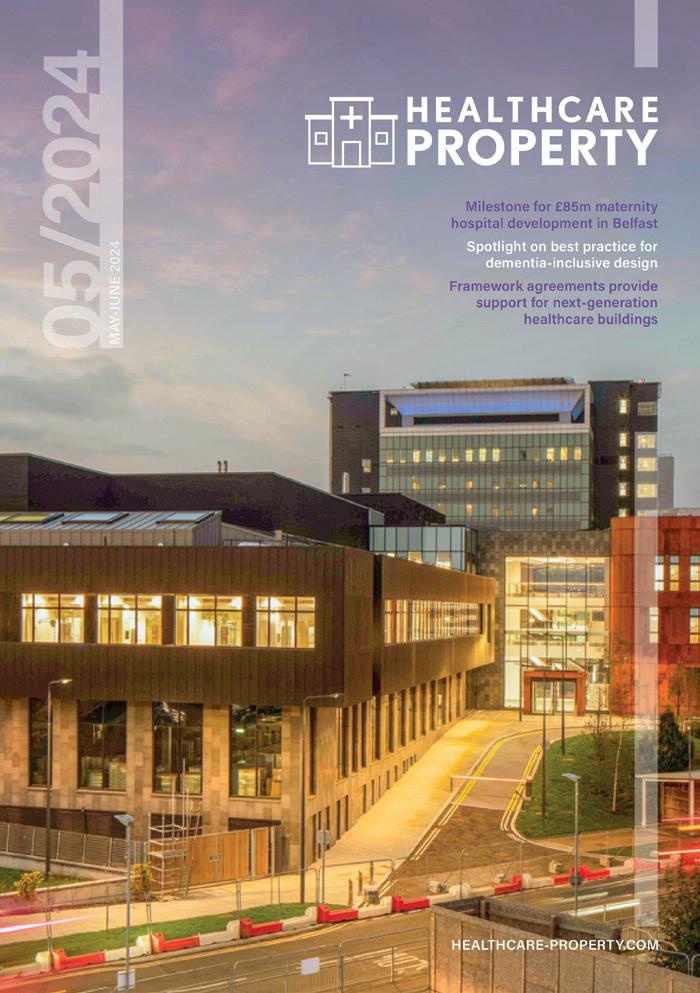
Inside issue 03, May-June 2024
• Milestone for £85m maternity hospital development in Belfast
• Spotlight on best practice for dementiainclusive design
• Framework agreements provide support for next-generation healthcare buildings

Inside issue 04, July-August 2024
• Advocating a simpler approach to the healthcare planning process
• The implications of a new accountancy treatment on NHS leases
• Designing mental health facilities closer to home
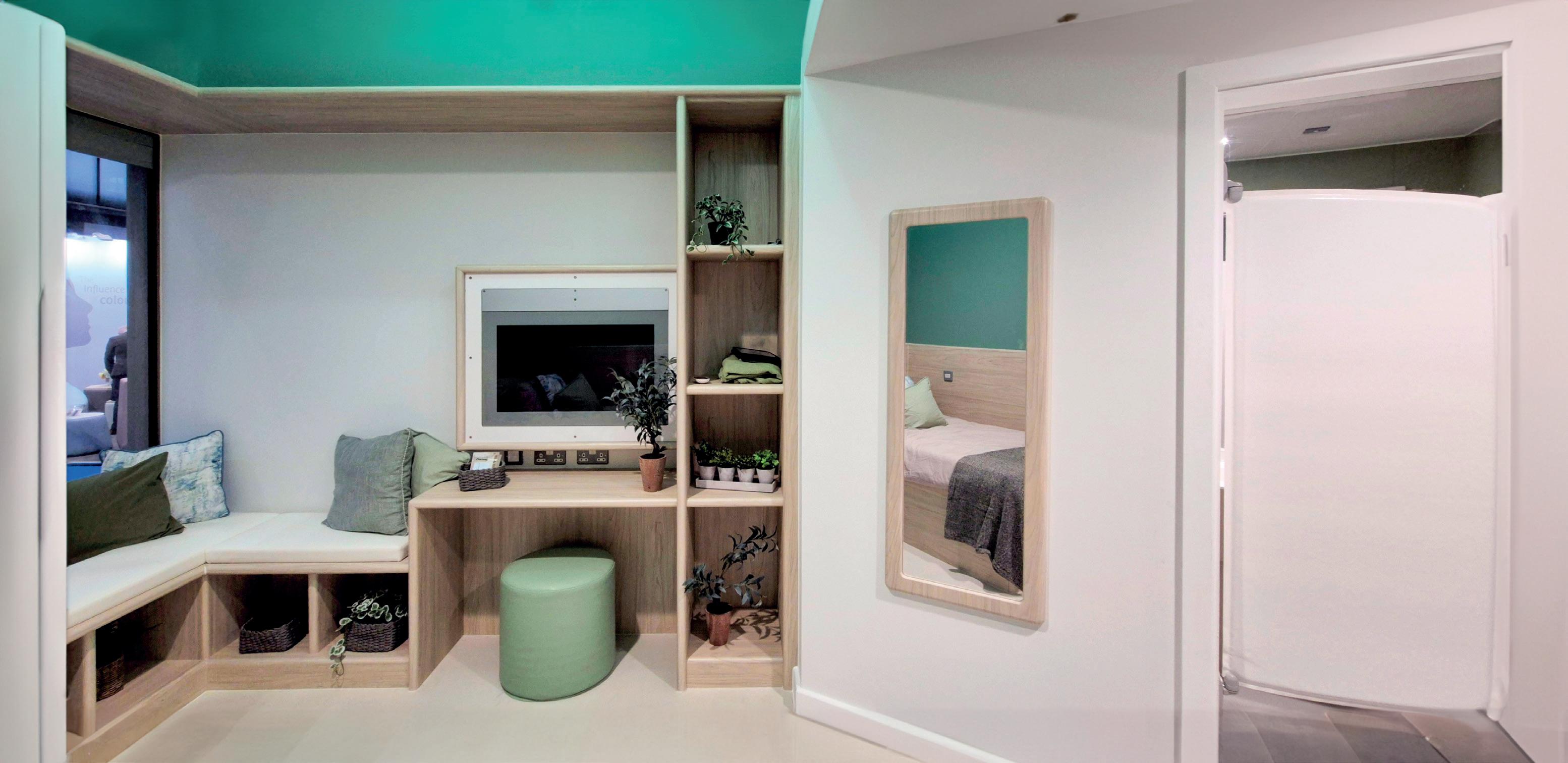
Exploring the design approach to Darwin Group’s innovative Bedroom Evolved modular mental health bedroom and the importance of manufacturers listening to feedback from end users
Industry experts and service users have welcomed changes to Bedroom Evolved; a pioneering modular mental health bedroom developed by healthcare construction firm, Darwin Group.
The firm recently showcased its new-look project at the Design in Mental Health Conference for a second year running and feedback from visitors was very positive.
The close collaboration with Tough
Furniture, Safehinge Primera, and Medical Architecture, has resulted in a space that is not only capable of meeting stringent BREEAM ‘Excellent’ sustainability requirements, but also addresses the specific needs of mental health service users.
Built and furnished entirely offsite in Darwin Group’s factory, this year the volumetric modular bedroom was taken to Manchester Central Conference Centre for the conference.
I’m coming to them from the point of view of where I’ve been in hospital, and I’ve seen that if you can’t keep it clean and if you can’t provide me with a warm, comfortable, vibrant, inspiring place, what am I supposed to do?
The incorporation of anti-ligature fixtures and fittings is a critical aspect of the design, ensuring the safety and wellbeing of patients.
And the offsite construction approach adopted by Darwin Group allows for a controlled environment that can potentially reduce construction time and costs while maintaining high quality standards.
This year, the team behind the bedroom made several improvements based on last year’s feedback, including an entirely-new interior fitout consisting of furniture, lighting, flooring, and colour palette changes.
One of the visitors to last year’s event was Nick Smith, who has personal experience of living through a mental health crisis and shared his views with the Darwin Group team about the design and what he would like to see from a modern mental health bedroom space.
He said it was vital that people in the industry listened to feedback from end users to create more-accessible and userfriendly spaces.

Last year, we had some incredible feedback from people about how it can be improved and what they would like to see, and we got firsthand knowledge from people working within the industry and users of this type of space, which really inspired us to go back and work on something that was even better
“Quite a few people at the Design in Mental Health Conference will hear me pick fault and think it’s ridiculous and say they can’t think of everything,” said Smith, who now helps to support vulnerable people who have suffered emotionally or experienced a mental health crisis through his peer support group.
“I’m not saying that they can, but I’m coming to them from the point of view of where I’ve been in hospital, and I’ve seen that if you can’t keep it clean and if you can’t provide me with a warm, comfortable, vibrant, inspiring place, what am I supposed to do?
“Being mentally unwell, you don’t trust people, you are naturally hyper vigilant, and you’re looking at things closely.
“What I liked about Darwin Group is that they took what I thought was quite harsh criticism last year really well, and I was really pleased that they had made some positive changes when I returned this year, including simple things like colour and choice of materials.
last year, but now they’ve got integrated internal blinds.
including in the shower where they’ve replaced a blue with a really-nice sage, earthy green.
explained why they couldn’t change certain things about the design for this year’s conference.”

The idea for the original Bedroom Evolved project came from the recognition that the NHS not only needs a high-quality, cost-effective solution that can be deployed at speed, but also one which provides a calming, serene place to improve people’s chances of responding successfully to treatment.
process, and careful, considered detailing to create a beautiful design.
“It’s about iteration and building onto all the thought that’s gone into the design of these spaces.
“Last year, we had some incredible feedback from people about how it can be improved and what they would like to see, and we got first-hand knowledge from people working within the industry and users of this type of space, which really inspired us


to go back and work on something that was even better and which we could bring back to this year’s exhibition.
“We worked really closely with Tough Furniture this year to develop an intentionally-minimal set of beautiful details, which is how we put the joinery back together.
“Quite a few people who saw it last year came back this year and instead of making comments about changes, this year they just sat in the room and spent time appreciating the space.
“Personally, I think the space feels more like a familiar piece of home rather than an institutional place that is there to enforce recovery on you.”
Sullivan said Smith’s first comment at last year’s conference was probably the most impactful.
“As soon as he stepped through the front door of the bedroom, he clocked that there was this microscopic kind of camera embedded in the media TV, which was only intended to give them access to their friends and family if they wanted to talk to them on a video call,” he said.
“Nick said he would not sleep in the bed because even if we told him the camera was off, he would think that it was watching him. It’s that kind of feedback we received which was fantastic.
“There were also comments made last year about how elements of joinery go together.
“Most of the comments last year were about safety and anti-ligature risk and we worked hard to introduce 18mm bullnose


It has really inspired me, knowing that good design can really be appreciated and make a difference in how we provide care for people
edges around all joinery, so it was a nice sinuous surface that was welcoming, safe, and cocooning.
“Changes to colour were also a big focus this year, and we went for a more-biophilic palette and used more-neutral, earthy, relatable colours. We also included design elements that encourage circadian rhythm through things like smart lighting that could be synced to the media screen and integrated blinds to create intentional atmospheres within the room.”
Sullivan said this year’s discussions with visitors were more about trust choice, their taste, and how they like to operate.
“It wasn’t a list of changes they want to see in terms of how we provide care,” he said.
“It was more to do with trust options, such as do they want to look after the patient’s belongings in the room themselves, so they no longer need a lost and found property cupboard.
“Do they want the bed in orientation A, B or C? Do they want to have the media TV or not?
“The buzzword this year was ‘serenity’
and trying to inspire calmness in the space.
“We had a really good comment from someone who just sat on the bed, looked at the joinery and edges and how the desk moulds into a bench, and felt we had really thought about them in the way we had designed the space.
“I’ve always appreciated that good design can heal, and just hearing that comment was evidence that what we designed was doing exactly what we intended it to do.
“Instead of that person wanting to pick at that space and wanting to take it apart, they felt more inclined to care for it and nurture it.
“It has really inspired me, knowing that good design can really be appreciated and make a difference in how we provide care for people.
“What we did this year absolutely paid off, and the comments we had were exactly what we were hoping for.”
He added: “My hope is that through built, functioning prototypes like Bedroom Evolved, which people can come to visit, spend some time in, and feel welcomed, we can foster an appreciation of the importance good design can make to mental health strategy and care.” n








As the health service struggles with the recruitment and retention of staff, we look at how one innovative model is helping to deliver modern keyworker accommodation that meets the needs of employees from the UK and overseas
Health and care workforces have been under immense strain, with NHS trusts reporting a staff shortfall of 150,000 employees — a figure set to rise to 360,000 by 2036 unless significant action is taken.
And one of the priorities for workers considering joining the NHS is where they will live.
Not only have economic pressures made private renting or purchasing homes unattainable for many health and care workers, but the standard of living in existing rental accommodation has declined rapidly, with widespread reports of mould, damp, and other major failings.
And, while dedicated keyworker housing
does exist across the UK, these are often designed in a similar way to student housing provision, typically with shared bathroom and/or kitchen facilities, and are deemed inappropriate for those working in the health and care sector who are usually older adults, often with families.
This has left a gap in the market for the next generation of keyworker accommodation, a gap which developer, Prime plc, is hoping to fill.
Michelle Robinson, associate director at Prime, explains: “The NHS has long been impacted by a lack of capital investment, as evidenced by an increasing backlog
maintenance requirement.
“It is understandable that constrained capital is focused on improvements to clinical spaces to support direct patient care. However, NHS staff also deserve quality accommodation.
“Ensuring staff have a safe, comfortable, and convenient place to live can significantly impact their wellbeing and, by extension, the quality of patient care.
“But investment in keyworker accommodation is not just a moral imperative; it’s a strategic one as reducing commute times and living costs can enhance job satisfaction, strengthen retention rates, and attract a morediverse workforce.”
…investment in keyworker accommodation is not just a moral imperative; it’s a strategic one as reducing commute times and living costs can enhance job satisfaction, strengthen retention rates, and attract a more-diverse workforce

Most existing keyworker housing schemes are operated by a housing group and offer a range of accommodation — typically studio or one-bed apartments — on a shortterm basis.
But there is very little available for staff more long term, or for those with families.
Hyve by Prime has been set up by Prime plc as a not-for-profit management company aimed at addressing the high demand for desirable, affordable, and bespoke keyworker accommodation close to hospital sites.
Offering flexible tenancy lengths that meet the changing lives of residents, developments are built to sustainable, energy-efficient, and functional building designs to create comfortable and safe spaces for health and care professionals to call home.
Robinson told Healthcare Property: “Recruitment and retention is a challenge for health and care operators — and is now the worst it has ever been.
“International recruitment over the last few years has exacerbated this challenge, with trusts having to find places for staff to live.
“Trusts have found that international recruits struggle to get into the private rental market as they may have no credit


history, guarantors, or UK bank accounts.
“Home-grown NHS employees are also struggling to afford their own homes.
“And many people make decisions on which jobs to take depending on if they can find somewhere to live and that they consider this affordable accommodation.”
Through Hyve by Prime, developers are looking to refurbish existing properties and construct new-build units up and down the country using a standardised design approach.
Robinson said: “Currently a lot of keyworker housing stock does not offer en-suite facilities.
“Our standardised design of one-, two-, and three-bed apartments ensures there is enough space and room to live.
“These are going to be people’s homes, so each apartment provides private en-suite bedooms, a kitchen, and living area.
“This flexibility means you could have three individuals living in a three-bedroom apartment, for example, each with their own en-suite bedroom, or you could have a family living there.”
Under its model, Prime plc is responsible for purchasing and developing each site. Partner organisation, Hyve by Prime, then uses its not-forprofit status to keep rents affordable for keyworkers.
And this means NHS trusts do not have to put the cost of providing this accommodation on their balance sheets, thus protecting their ever-dwindling capital.
With keyworker developments recently having been built in Yeovil and Dorchester, NHS trusts now have a way to provide appropriate and long-term accommodation and in turn attract much-needed new talent.
Robinson said its research had revealed that while the optimal site for these developments in within trusts’ own estates; they are also looking further afield and working with local authorities to find additional sites, such as vacant high-rise blocks.
Robinson said: “We look for sites within 20 minutes walk from the hospital site due to the cost of travel and parking.
“In big cities, where public transport is better, we may go slightly further out, but, after a 12-hour shift, staff want to get home quickly.
“They also want to be safe and we have rejected sites where we would not want to walk that route home. Safety is very important.
“We then work with trusts to understand what accommodation they already have, what they need, and who they want to place there.”
In Yeovil, Prime secured £21m in funding to develop a new-build 176-bed complex across 66 apartments.
The units were funded by Canada Life and built by Speller Metcalfe.
And, in Dorchester, Hyve by Prime provided 63 oneand two-bed apartments just a 10-minute walk from Dorset County Hospital.
Robinson said: “Housing costs in Dorset are significantly above the national average.
“Set against a crisis in medical staffing, the increased costs of employing agency nurses has seen the trust

The commercial structure and funding model created ensured the new accommodation met our needs without requiring NHS capital, demand guarantees or approvals — meaning our staff could move into their new homes quickly
employ a growing number of overseas nurses in recent years.
“In addition to offering homes to international and UK-based staff, the trust believes that a major incentive to work at DCH is to provide good quality, wellmaintained accommodation close to the hospital and this is what we have done with the Alexandra House development.”
Nick Johnson, deputy chief executive at Dorset County Hospital NHS Foundation Trust, added: “Here in Dorset, a lack of accommodation offering is further exasperated by its rural location and the fact that it is a holiday hotspot, with one in 13 houses a holiday home.
“I recall during one hospital walkaround a valued colleague telling me that they were moving to another NHS trust across the country simply because house prices were much cheaper and they could afford a family home.
“With this region-specific challenge staring us in the face, we turned to Prime to help us find a solution, and fast.
“The commercial structure and funding model created ensured the new accommodation met our needs without requiring NHS capital, demand guarantees or approvals — meaning our staff could move into their new homes quickly.
“By mitigating the housing-related barriers to recruitment and improving staff retention rates, we will reduce the financial strain associated with constant turnover.
“Consequently, this helps us allocate resources more effectively, enabling enhanced patient care, investment in training and improved overall service delivery.” n



Entries are now being invited for the 2025 Healthcare Design Awards.
Previously run by Pinders, the awards, which were first launched in 1991, were last year taken over by Nexus Media Group, which also publishes Healthcare Property magazine.
The competition recognises innovation and excellence in the design of health and care facilities across the UK.
And the categories for next year’s competition have recently been announced. There are a total of six trophies up for grabs in 2025. They are:
• Best Architectural Design: Recognising outstanding architectural design of a new care home, taking into account innovative layouts and aesthetics
• Best Interior Design: Recognising creative interior design of a new care home – e.g. use of colour, materials, and signage to improve the resident experience


• Best Exterior Design: Recognising standout design of care home gardens, terraces, balconies, and other outdoor spaces
• Best Specialist/Dementia Care Design: To be awarded to facilities for specialist or dementia care where innovative design has improved the lives of residents or patients
• Best Acute Care Design: Recognising innovatively-designed facilities for acute care service delivery
• Best Primary Care Design: To be awarded to innovatively-designed facilities for primary care
Jo Makosinski, editor of Healthcare Property, said: “The way we design health and care buildings is critical to the delivery of effective and efficient services.
“Increasingly, the environment is playing an even more-important role, and these

awards aim to recognise this by rewarding those who are innovating in order to provide the very-best settings for modern health and care services.
“Whether they be care homes, GP surgeries, hospitals, or specialist care centres; the Healthcare Design Awards will celebrate those projects which are setting a precedent for the future, both in the UK and overseas.”
The entries will be considered by a panel of experts, with the winners being announced at a ceremony at the Royal Lancaster Hotel in London on 13 February 2025.
For more information on how to enter the awards, or for details of sponsorship packages and tickets to the ceremony, scan the QR code or visit the website at https:// healthcaredesignawards.co.uk


Jo Makosinski speaks to Bonnie Chu of Wates to explore the challenges facing estates managers in ensuring compliance with fire regulations in healthcare settings
Following the Grenfell Tower fire in June 2017, it became clear there was a need for the Government to step in and change legislation for high-rise buildings (HRBs) so that such a tragedy never occurs again.
And, building on the recommendations within Dame Judith Hackitts’ Independent Review of the Building Regulations and Fire Safety, published in May 2018, the Building Safety Act received Royal Assent on 28 April 2022.
It takes forward the commitment to fundamental reform of building safety by strengthening the regulatory system and ensuring greater accountability and responsibility for fire and structural safety issues throughout the lifecycle of buildings.
Legislation provides a laser focus on quality, with building regulations front and centre. Under the legislation building owners will be required to manage safety risks, with clear lines of responsibility for safety during design, construction, completion, and occupation of high-rise buildings.
It will also require a ‘golden thread of
information’, with safety considered at every stage from design to occupation.
And building owners will need to demonstrate that they have effective, proportionate measures in place to manage safety risks, and will need to register their buildings.
Significant incidents that cause loss of life or injury will need reporting to the Building Safety Regulator, which will sit within the Health and Safety Executive (HSE).
The Regulatory Reform (Fire Safety) Order 2005 will also be amended to ensure tougher sanctions for non compliance and those who do not meet their obligations may face criminal charges.
These changes are having a significant impact on hospital estates and facilities managers as, while they primarily focus on residential buildings, the introduction of a new regime for ‘higher-risk buildings’ of at least 18m high, or with at least seven storeys, applies to many hospital tower blocks and some care home units.
Of particular note for new or existing healthcare facilities looking to undertake variation or expansion works will be the proposed new gateway procedure.
This is intended to ensure that fire safety plays a key factor in the design and occupation of buildings and will need to be factored into the planning stage for any new construction project.
So, what can trusts do? And how do they ensure they do not falling foul of the
To address this issue, Bonnie Chu, design director at Wates, is developing a White Paper, due to be released later this year, which will explore the challenges with fire compliance on healthcare estates.
Developed in conjunction with HLM Architects and fire and risk consultancy, OFR; the document will be informed by a series of roundtable discussions exploring the challenges that healthcare providers are facing with achieving fire compliance; their experiences in delivering positive outcomes while working in live, clinical environments; lessons learnt; and some of the unprecedented challenges facing the NHS.
Chu said: “We had some great discussions, sharing lessons learnt, including the complexity of hospital estates, experiences with managing expectations upwards and with staff/patients/visitors, and funding challenges, such as prioritising where to spend the funding.
“It was clear that NHS trusts are ALL facing similar, if not the same, challenges.”
She added: “We believe the buildings and spaces health services operate from should enable them to expand, develop, and enhance the valuable work they deliver for the patients in their care, without the worry of fire compliance issues and the serious risks associated with inadequate protection for staff, patients, and visitors.”
Through her research she has identified four common challenges facing healthcare estates managers when it comes to fire safety within their estates:
• A lack of accurate estates information
• Lack of compliance with current statutory recommendations
• These are not typical capital projects
• Stakeholder management
She said that while most trusts have fire risk assessments, the key to compliance, and ensuring the safety of all building users, was an up-to-date fire strategy for existing facilities.
She added: “Are we giving enough
importance and emphasis to having an upto-date fire strategy for retained estates?
“New-build projects will have a dedicated fire strategy, but what about retained estates?
“How do we expect estates team and fire consultants to undertake fire risk assessments without a strategy?”
And she called for greater collaboration and a focus on fire safety from the very start of any building project.
“The resounding message from our round table events was that we must accept the traditional approach to procuring capital projects does not work for these types of projects and that early cross-industry collaboration on projects is essential to driving forward change and delivering the outcome efficiently and effectively.
“The discussions always circled back on the need to collaborate and work together from the inception of fire compliance projects — get the client, designers, fire engineers, and contractors together so we all understand and develop the right affordable solutions to mitigate and engineer out fire risks where possible.
“Is this perhaps a return to what design and build is meant to be — the contractor comes on board early with their design team?
“I would like to think that having been an architect, and now working for a main contractor, this is where I’m best place to drive this collaborative approach to ensure we achieve success in these complex projects.
“Every trust is different and their experiences are differing, so we need to develop a strategy that works for them and starts breaking down what needs to be done, sooner rather than later.
“We also need to consider the estate as a whole, rather than just pockets of it.”
Her research comes as reports of fires and fire safety issues at hospitals across the UK continue.
In March of this year figures from NHS Digital revealed a concerning rise in fire incidents recorded by NHS trusts, with 1,372 fires reported in the 2022/23 period.
This marks an increase of over 18% from the previous year, translating to almost four fires daily across the NHS.
One of these incidents, in June 2023, led to patients and staff being evacuated from Watford General Hospital after a blaze broke out in a basement electrical store.
And earlier this month patients were moved from a stroke ward at Cornwall’s

The discussions always circled back on the need to collaborate and work together from the inception of fire compliance projects — get the client, designers, fire engineers, and contractors together so we all understand and develop the right affordable solutions to mitigate and engineer out fire risks where possible

Love British Food has produced and released a film to inspire NHS catering managers, procurement teams, and trust chief executives to consider the connection between how food is produced and its contribution to patient outcomes.
The film was shot onsite during the ninth farm visit for NHS caterers through the Love British Food Hospitals and Care Catering Working Group to the Holkham Estate in Norfolk.
The visit to one of Britain’s largest historic country estates, and the largest privately-owned nature reserve, was hosted by Jake Fiennes, director of conservation.
The Holkham Estate leads the way in delivering exceptional
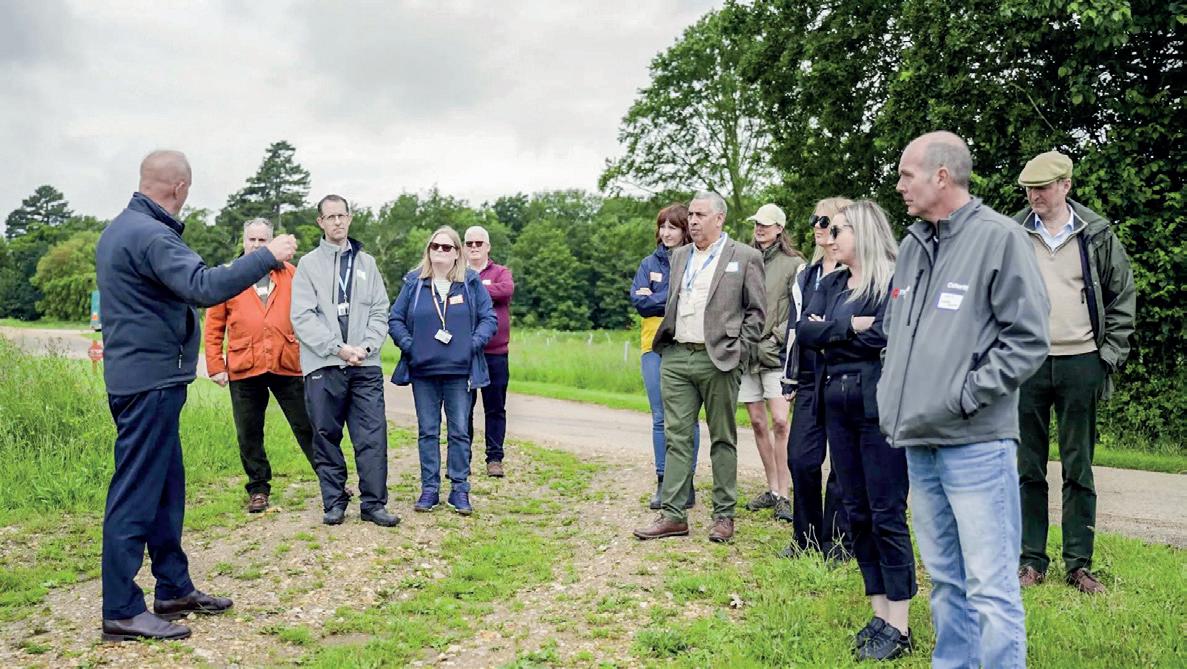

food production, together with pioneering conservation, and is focused on soil health, connecting habitats, enhancing the environment, developing science-led innovations, and making operations leaner and greener.
Alexia Robinson, founder and
chief executive of Love British Food, said: “We know it is not enough to ask catering teams to buy British. We need to explain why.
“The aim of these farm visits has been to enthuse catering teams to see buying British as a carrot rather than a stick, as I
At its spring conference, the Textile Services Association (TSA) presented a new standardised test protocol for evaluating the disinfection efficacy of laundry wash processes in hospitals.
This marks the latest stage in the ongoing partnership between the TSA and De Montfort University (DMU), which they believe will help to guarantee the effectiveness of infection controls in healthcare laundry services.
The new protocols have been developed following a four-year research project led by Professor Katie Laird at DMU, which was funded and supported by the TSA and other national associations from Europe and America.
The research aims to provide accurate information and usable methods of ensuring hygienic cleaning of textiles, particularly in relation to sectors more vulnerable to infection, such as healthcare.
TSA board member, Simon Fry, himself an owner of a specialist laundry firm, explains why this work was necessary. “The idea for
this project came about when manufacturers began introducing chemicals for cold washing,” he says.
“While it’s a great idea in terms of energy saving, it can introduce risks in terms of lesseffective disinfection, which is compounded if the traditional tests being used weren’t giving accurate results.
“You could almost pick the test to get the results you wanted and I realised that we would need something that accurately showed the kill rates of bacteria, which could be used by all stakeholders to deliver data that allows everyone to work on a level playing field.”
The research aimed to create standardised testing protocols that definitively measure how many pathogens are killed by laundry washing processes.
In order to achieve this the DMU team needed to study existing infection controls and the current processing methods for healthcare laundry. They also needed to understand the attitudes and knowledge of healthcare staff in terms of infection control
fear the perpetually-consultedupon New Government Buying Standards make it sound.
“I genuinely believe these visits have created excitement about buying British in NHS catering teams.
“Together with the farmers who have hosted the visits with me, we have answered the question ‘Why buy British’ and explained how doing so contributes to patient outcomes, sustainability, net zero goals, and trusts’ roles as anchor institutions for supporting their community.”
The short film encompasses some of this philosophy, and included feedback from some of those who attended the Holkham Estate visit.
Love British Food has now hosted 43 hospitals from 36 NHS trusts on farm visits.
policies and how these apply to textiles.
Alongside funding the research, the TSA also organised surveys of its members in the UK as well as overseas.
The test developed by Professor Laird and her team accurately demonstrates the disinfection efficacy of laundry during a wash process in a way that can be used throughout the healthcare sector, whether it is in outsourced or on-premise laundries.
The test involves placing a sample of inoculated fabric within a membrane, which looks similar to a teabag, that allows water and chemicals through, but stops bacteria from escaping, meaning that the effectiveness of the decontamination of the laundry process can be properly evaluated.
This allows for a like-for-like comparison of different washing methods and equipment types.
The next phase will see the test methodology incorporated within best practice standards driven by the other national associations including the TRSA in America and ETSA in Europe.





In this article we consider the importance of seeking legal advice before embarking on longterm carbon reduction projects within the NHS
With the NHS having been set tough targets to reach net zero carbon emissions by 2040, the race is on to implement changes at pace.
And this challenge is being supported by a number of energy efficiency procurement and financing frameworks.
While these are helping trusts to find the necessary funding for often-high-value interventions, and providing the legal support for contracts between health organisations and private technology and service providers, there are still risks associated with these long-term contracts.
Recently, UK law firm, Mills and Reeve supported South Warwickshire University NHS Foundation Trust on the implementation of an energy infrastructure and energy infrastructure maintenance contract funded through phase 3b of the Public Sector Decarbonisation Scheme (PSDS) and delivered through the Carbon and Energy Fund (CEF) Framework 5 agreement.
Under the agreement, contractor, F P Hurley & Sons, will install air source and water source heat pumps and a new district heating mains feed to the trust’s satellite plantrooms at Warwick Hospital.
The works also include the installation of solar PV panels and a comprehensive upgrade of windows at the hospital.
Over the next 15 years, the works will deliver an estimated saving of 11,313 tonnes of CO2e, and save in excess of £150,000 on energy and maintenance costs.
But, while the standard contract provided under the CEF agreement sets out guarantees from the contractor in terms of expected energy and cost savings; trusts are being advised to seek legal advice to ensure that the contractor’s performance meets any carbon intensity and other net-zero parameters.
Benjamin Bull, senior associate at Mills and Reeve, told Healthcare Property: “Projects such as this go some way to

reaching the ambitious targets set by NHS and its aim to become the world’s first netzero health service.
“However, it is vital that the trust looks at the detail within the contract to ensure it sets out the agreed level of service with clear obligations for the contractor to meet.”

While there is not much scope to significantly change the terms of these standard contracts, we have been able to provide the trust with guidance on how to ensure they are executed properly
Nick Helm, infrastructure and energy lawyer at Mills and Reeve, adds: “While there is not much scope to significantly change the terms of these standard contracts, we have been able to provide the trust with guidance on how to ensure they are executed properly.
“Our first task was to look at the wording of the contract and what the trust and the contractor were expecting from the agreement.
“We did some work around the trust’s liability as the heat pumps were being installed on estate it owns, so there is a responsibility to ensure the site is maintained.
“This is a major long-term financial agreement for the trust, and it is crucial that it understands all the risks and liabilities.”
And Bull advises: “As this contract covers installation and maintenance over a long period of time, the contract must ensure the equipment is being maintained and the contractor is meeting the agreed service

requirements from a technical position, with any dip below the agreed level resulting in the trust having recourse.
“For us this involves looking at how the contract is structured throughout the course of the agreement.
“Firstly, we need to find our what the trust’s sustainability officers expect the project to deliver and what the contract provides for.
“Over such a long period of time, people involved in the contract from both sides may change and the contract needs to provide a commitment that will ensure it is adequately managed, regardless of the individuals involved.
“There also need to be termination clauses covering when both sides can terminate the contract and what obligations lie with each party, which differ depending on when in the term of the contract termination occurs, should this happen.

Helm
“This is why we would advise trusts to seek advice early in the process to ensure those contracts have been reviewed and that they cover every possible eventuality and support the trusts to deliver their goals.”
Commenting on the work, Cristina Calleja, sustainability manager at South Warwickshire NHS Foundation Trust, said: "We are very excited to be developing our site with a sustainable future in mind.
“This project will form the foundations of a new and long-term relationship with our sub contractor and we are grateful for the support Mills & Reeve provided while navigating the agreement and signing of



Jonathan Freeman, group sustainability director at CareTech Group, reveals how social care is adopting a green agenda, asking how a competitive care sector can work together to tackle sustainability challenges
Rightly or wrongly, the social care sector is a complex patchwork of provision, from local authority run, to charity operators, to private provision. That was the political decision taken by successive governments and it’s unlikely this mixed economy will change soon.
But it does pose some serious questions as to how best to tackle sustainability challenges.
With commissioners driving ever-harder funding decisions, all of us in social care tend to default to competition. How can we deliver more than our competitors? How can we deliver at a lower cost? How can we get people to work for us, not our competitors?
Where does sustainably fit into that mix? In particular, how can we square the baked-in competitive nature of the sector with environmental sustainability, when tackling the climate crisis effectively requires collaborative effort of the like not seen before?
First, we need to work with commissioners — particularly those in local authorities — on our sustainability efforts.
Local authorities are increasingly seeking to drive pressure on their providers to achieve their own sustainability targets. And the Government is under pressure to
support local authorities to up their game.
For social care providers with NHS contracts, the sustainability requirements are increasingly stringent with all contracts for £5m requiring the operator to set out a public carbon reduction plan.
A collaborative approach between the sector to drive collective change is therefore essential.
Each commissioner appears to have its own approach and its own asks of providers, creating unnecessarily complicated and wasteful work.
We need to work together, agree our shared priorities, streamline, and make consistent the asks of commissioners on providers.
We also need to work together with the Local Government Association and the Association of Directors of Adult Social Services to agree on expectations on sustainability that will support the ambitions of local authorities and the social care sector alike.

All too often, social care providers look to succeed by competing with other providers. That approach will simply not work when it comes to sustainability
Secondly, we need to collaborate with our suppliers, all of whom are, of course, on their own sustainability journeys.
To address our indirect emissions, known as Scope 3, we have to work with all of our suppliers to drive down our carbon emissions.
These emissions include, for example, all of the products that operators buy, use, and dispose of from suppliers.
As those operators looking at their indirect emissions are discovering, the majority (typically, around 70%, but often as high as 85%-95% of an organisation’s indirect carbon emissions are driven by these Scope 3 emissions).
It is inevitable that suppliers to the sector will want to address their own carbon emissions as regulators, national and international, up the ante on these issues.
Consumer demand, however, is likely to drive the pace more quickly. At CareTech, we have found just asking a simple set of questions of our suppliers about their approach has unlocked some mutuallybeneficial opportunities.
Our stationary providers, for example, have swapped in a new range of recycled
and more-environmentally-sensitive products at no extra cost.
And our cleaning products supplier is piloting a range of new products that promise to reduce plastic waste dramatically — again, at no extra cost.
And this is just from opening up the conversation with our suppliers.
Thirdly, we need to start working together more as operators. That’s why a group of us came together to establish the Social Care Sustainability Alliance.
The alliance brings together senior leaders in providers across the social care sector
to pool their thinking on sustainability, to work together on the tricky issues with which we are all grappling, and to support more providers to start or accelerate their sustainability journeys.
The alliance has already published a comprehensive ‘Business case for sustainability in social care’and other papers on the way include those on retrofitting for older properties, the expectations of investors, a guide to statutory and voluntary requirements on sustainability, and best practice on measuring and reporting on carbon emissions.
By working together in this way, we will all make faster progress on key issues, and we will all benefit as a result.
All too often, social care providers look to succeed by competing with other providers. That approach will simply not work when it comes to sustainability.
Sustainability gives us a very-real and pressing opportunity for the sector to come together behind a shared objective to make a deep and lasting change for the better.
Perhaps, this might even be a lesson that we could apply more generally to tackling the challenges facing the social care sector. n
Sustainability gives us a very-real and pressing opportunity for the sector to come together behind a shared objective to make a deep and lasting change for the better
Sustainability and waste experts, Business Waste, share the top strategies that hospitals can apply to run more sustainably
Ahospital’s primary focus should be to provide care for its patients. But there is also an increasing need to adopt more-sustainable practices within the institution.
And hospitals are now under more pressure than ever before to reduce their environmental footprint.
Integrating waste reduction strategies into hospital operations offers a direct and impactful approach to address this challenge.
With this in mind, sustainability and waste experts from Business Waste have shared the top strategies that hospitals can apply to run more sustainably.
1. Introduce comprehensive recycling programmes
Recycling is the foundation of sustainable waste management.
Hospitals can reduce waste by implementing comprehensive recycling programmes that go beyond paper and plastics to include metals, electronics, and glass.

Special attention should be given to recycling single-use medical devices which, after proper sterilisation and reprocessing, can safely be reused.
Advanced segregation techniques will take this a step further.
For example, clear signage and distinct bins should be used for the following categories: infectious waste, pharmaceutical waste, chemical waste, and radioactive waste.
Hospitals should partner with certified recycling companies that can provide bins and containers for these waste types, and the segregation will not be such a complicated and time-consuming process.
2. Invest in reusable products and materials
Transition from single-use to reusable products where possible in your hospital.
This plays a big role in moving towards a more-sustainable administration.
It could include items such as surgical instruments, linens, and even certain types of personal protective equipment (PPE).
Investing in durable and reusable alternatives reduces waste, but also decreases long-term costs associated with purchasing disposable items.
Hospitals must ensure, however, that
the transition to reusable items does not compromise patient safety by adhering to strict sterilisation and handling protocols.
3. Optimise energy and water use
Sustainability in hospitals is not limited to waste management; it also covers efficient use of energy and water.
Hospital management should look into waste audits, which should check all the main systems including lighting, heating, ventilation, and air conditioning systems.
Are they as energy effective as they can be? If not, consider replacing old bulbs with LEDs, which are a lot more efficient and long lasting.
Hospitals can also replace some of the old heaters with smart thermostats that are guaranteed to save both costs and energy.
And they can consider adopting watersaving fixtures, which will help reduce water overuse too.
Conducting regular energy audits and investing in more energy-efficient devices and technology can further enhance sustainability efforts in your hospital.
4. Foster a culture of sustainability Last, but not least, fostering a culture of sustainability within the hospital
is essential.
This involves educating and engaging all staff members, from administrative personnel to nurses and doctors, about the importance of sustainable practices.
Encourage staff to participate in eco initiatives and provide training and guidance on the hospital’s green goals and what each one of them can do to help achieve them.
The most eco-conscious and diligent staff members could even be rewarded.
Hospitals can also engage patients to take part in their sustainable efforts by promoting an overall culture of environmental care, responsibility, and action.
By incorporating at least some of these strategies, hospitals should significantly reduce their waste output and move towards more-sustainable operations.
The benefits of such practices extend beyond environmental impact; they also include financial savings, improved patient and staff satisfaction, and a stronger reputation in the community.
As pillars of health and wellbeing, hospitals that also take an interest in green practices will lead by example within their communities. n
Waste management specialist, Mitie, has been awarded a contract to collect and manage all healthcare-related waste produced by the Nottingham University Hospitals NHS Trust.
The contract includes hospital gowns, gloves, testing kits, and other single-use plastics from Queen’s Medical Centre and Nottingham City Hospital.
The waste will be treated using Mitie’s specialist autoclave technology — a sustainable waste management alternative — which can treat up to 1.8 tonnes of infectious waste, like sharp syringes, swabs, and dressings, every 45 minutes.
By using the autoclave technology, the trust’s clinical waste will be treated with high-pressure steam which destroys bacteria and pathogens on the material, preparing it for safe disposal.
Whenever possible, Mitie will also work with partners across the UK to recycle and repurpose the decontaminated material by turning it into plastic pellets that can be used to make new products to be used in healthcare environments, supporting a circular economy.
A spokesman for Mitie said: “This method is far more sustainable than the traditional carbon-intensive, hightemperature incineration process which destroys waste at over 1,100˚C, and does not allow for recycling.”
Cliniwaste, a specialist in treating waste

from healthcare environments using alternative treatment, was acquired by Mitie in October 2023 and will be central to the delivery of the contract. Cliniwaste’s Nottingham treatment facility is located just three miles from Queen’s Medical Centre, ensuring waste will only travel a short distance before being treated, further enhancing sustainability across the contract, and assisting the NHS in its decarbonisation targets.
Michael Taylor, managing director of Mitie Waste, said: “This contract not only demonstrates our approach to innovative waste treatment, but also our commitment to supporting the NHS in achieving its sustainability targets.
“Through our expert Cliniwaste team, and our advanced autoclave technology, we can ensure that all clinical waste across the trust is managed efficiently and responsibly, contributing to a greener future for healthcare.”
Five healthcare trusts have come together to form the Circular Economy Healthcare Alliance in a display of commitment towards a greener and more-sustainable NHS.
University College London Hospitals (UCLH), University Hospitals Sussex, Cambridge University Hospitals, Imperial College Healthcare, and Chelsea and Westminster Hospital NHS Foundation Trust will co-operate to help reduce waste and associated carbon emissions.
In a joint statement, the trusts said: “Our collaborative group of NHS trusts aims to reduce single-use medical equipment and consumables, reusing wherever it is clinically feasible and appropriate to do so.
“This will be reflected in our evaluation criteria for selecting products and suppliers through the procurement process, and through building skills, knowledge, and
processes in our trust to enable this transition.”
Professor Mahmood Butta, a consultant ear, nose and throat (ENT) surgeon and clinical lead for environmental sustainability at University Hospitals Sussex, is spearheading the alliance.
He said: “The NHS in England generates 440 tonnes of medical waste a day.
“While discarding items has become commonplace, our research and analysis reveals that this is often unnecessary and perpetuated by misconceptions about infection risk.
“By forming this alliance, we advocate for a shift towards using reusable products whenever safe to do so, and will always use suppliers that value sustainability. We encourage others in the NHS to join us.”
The alliance is focusing on three key areas of change:

Joe Burton, sustainability transformation project lead at UCLH, said: “Our ambition is that this alliance signals to suppliers a shared desire to change the way that trusts procure single-use items in favour of reusables, supporting the national objective for the NHS to be net zero by 2045.
“We have multiple projects underway at UCLH to reduce our use of single-use items and continue to share our progress with the alliance.”
One of NHS Grampian’s assistant domestic services managers is being recognised for single handedly cutting waste by 1,300 bags of rubbish every week.
Aaron Sutcliffe, 32, who is originally from Manchester and now lives in Elgin, joined NHS Grampian in 2016 as a domestic and has been promoted three times since.
And he has now been handed a Green Star Award for his efforts to reduce the health board’s impact on the environment.
His passion for removing general waste bins in favour of fewer recycling stations started when he looked after Ashgrove House in Aberdeen.
He has since gone on to transform the way waste is handled in the warehouse at Aberdeen Royal Infirmary as well as two floors of offices in the hospital’s Yellow Zone and at Foresterhill Health Centre.
Overall he has helped colleagues ditch nearly 450 general waste bins, which equates to more than 1,300 black bags every week.
He said: “We’ve found engaging with people is the most-important bit — asking ‘we would like to’ and explaining we’re trying to make a positive impact on our sustainability goals.
“Every single general waste bin I’ve ever
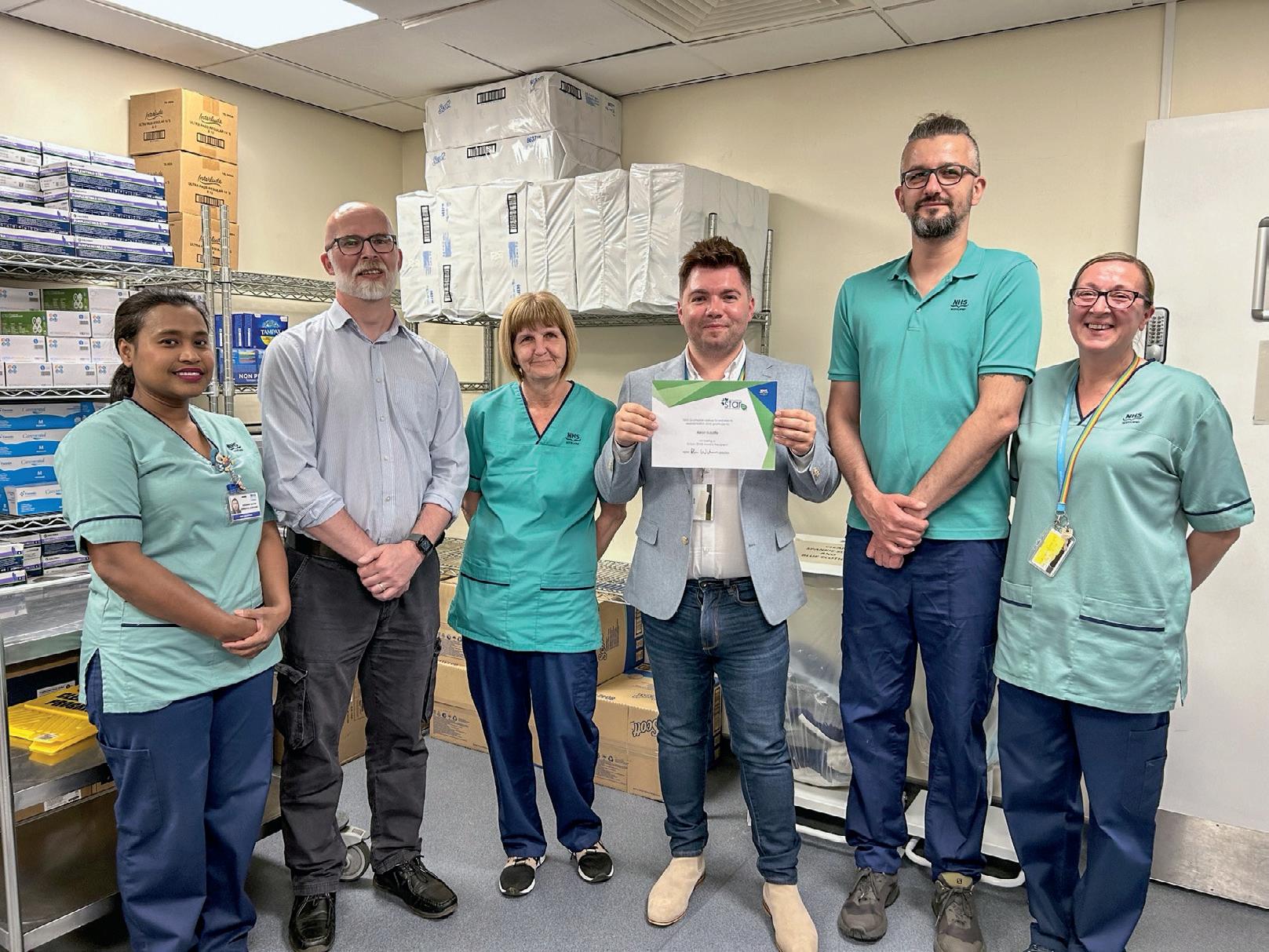
up and about too.”
Sutcliffe was presented with a certificate by waste manager, Neil Duncan, who said: “Swapping lots of small waste bins for fewer recycling points helps encourage staff to recycle and it reduces the workload for our domestic assistants.
this is commendable work which should be replicated across all areas.”
The organisation currently spends around £125,000 every month disposing of clinical waste alone and it is estimated that recycling more of this could save the health board at least £150,000 per year.
The Welsh Ambulance Service has been recognised for its commitment to reducing its environmental footprint and improving performance.
The trust has been awarded the 14001 Environmental Management Systems Standard by the British Standards Institution after a rigorous five-day inspection of its environmental governance system.

ISO 14001 is an internationally-recognised standard for environmental management systems, which supports organisations in identifying, managing, monitoring, and controlling environmental processes.
And the Welsh Ambulance Service is currently the only ambulance service in the UK to hold this standard.
Richard Davies, the trust’s assistant director of capital and estates, said: “To retain accreditation is a massive achievement.
“It’s a validation of the great work headed by the estates team and especially environment and sustainability manager,
Nicci Stephens; and environment and sustainability support officer, Sharon Jones.”

The trust introduced a catalogue of new initiatives in its bid to secure ISO 14001, including new plug-in hybrid rapid-response cars to replace the older diesel-powered vehicles; 270 speed-limited non-emergency patient transport vehicles installed with solar panels to minimise the need for mains charging; the use of video conferencing to reduce travel time, emissions, and cost; installing new renewable energy systems; and reducing reliance on fossil fuels by
installing low-carbon heating.
Stephens said: “The accreditation provides assurance to the trust’s management and employees, as well as external stakeholders, that the environmental impacts of the trust are being measured and improved.
“The assessor noted that, during their visit, the trust demonstrated that the environmental management systems in place continue to support the strategic direction of the organisation and achieve objectives relating to improving environmental performance, which we are very proud of.
“In order to support the Welsh Government’s ambition of a net-zero carbon public sector by 2030, we have developed a decarbonisation plan and are working towards the NHS Wales decarbonisation target reduction of 34%.”
The trust was accredited following an audit which took place at a sample of stations and office buildings across Wales during May.





